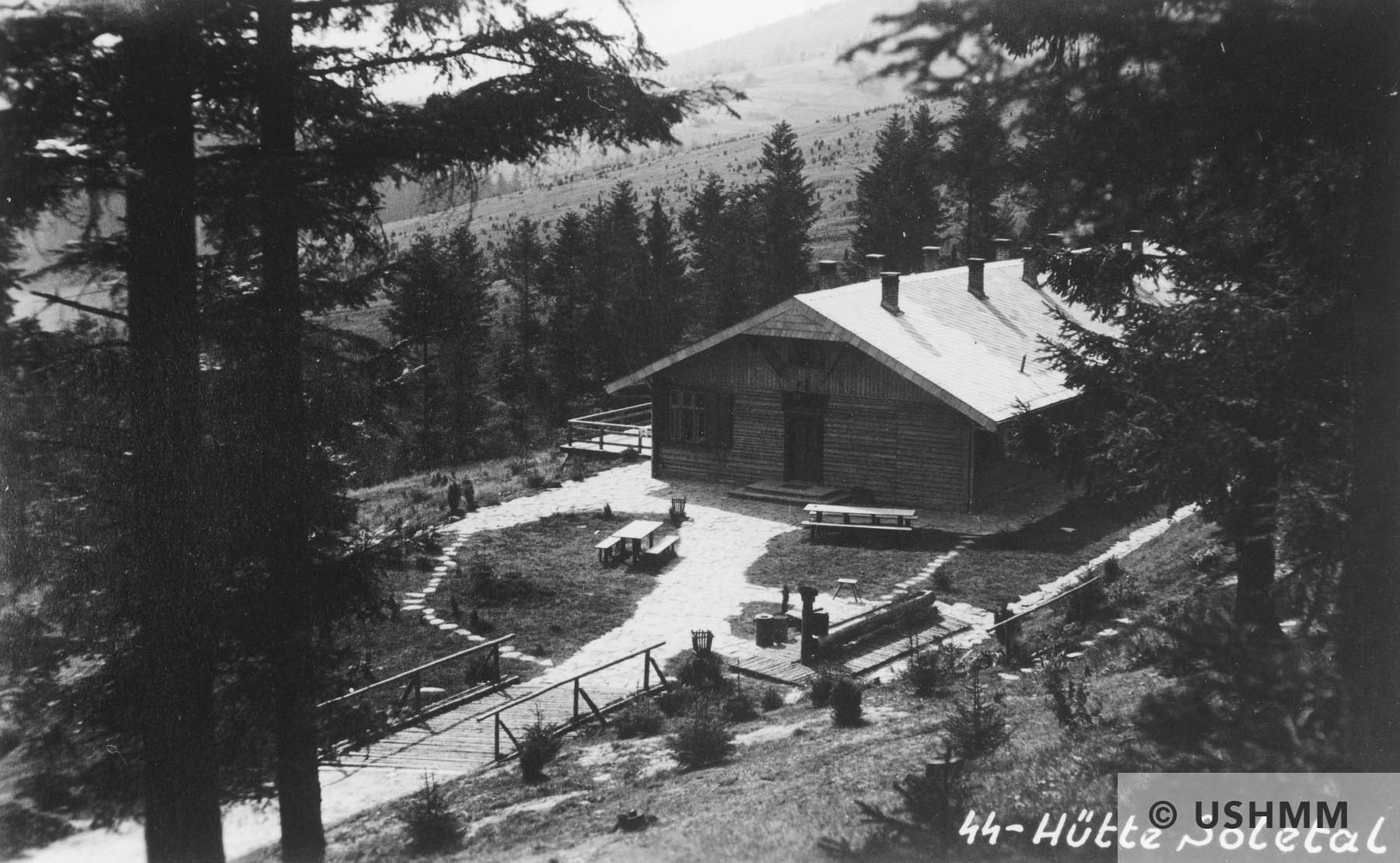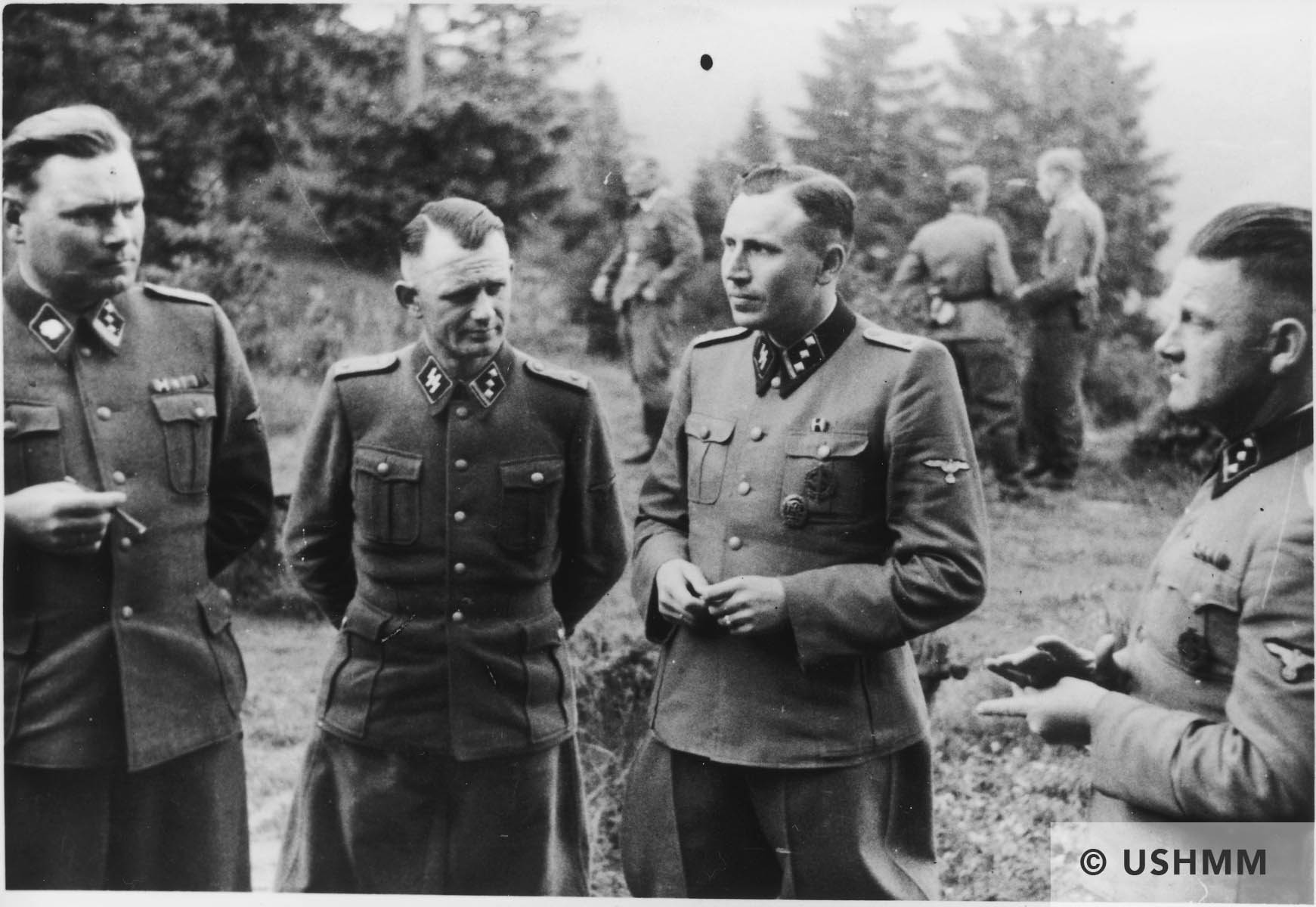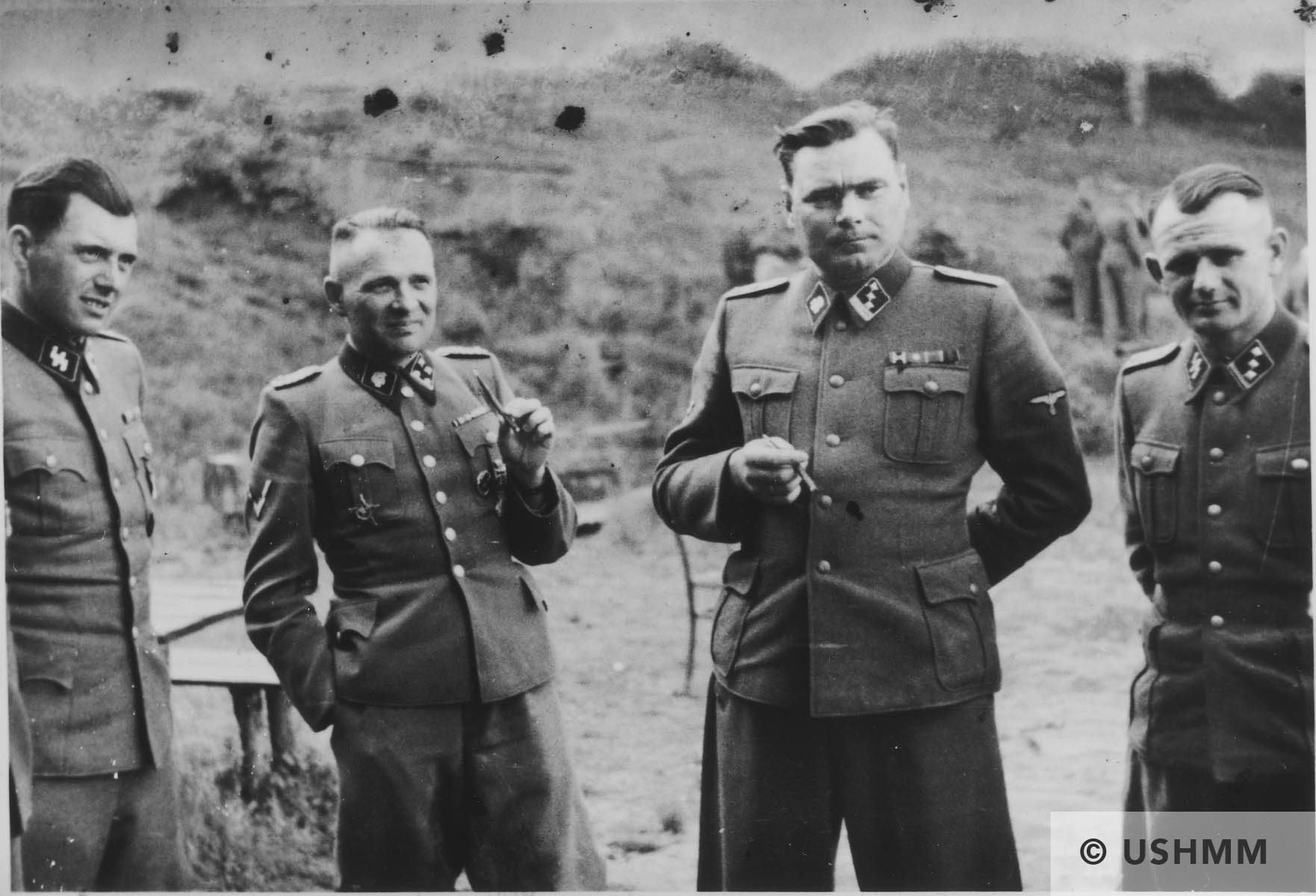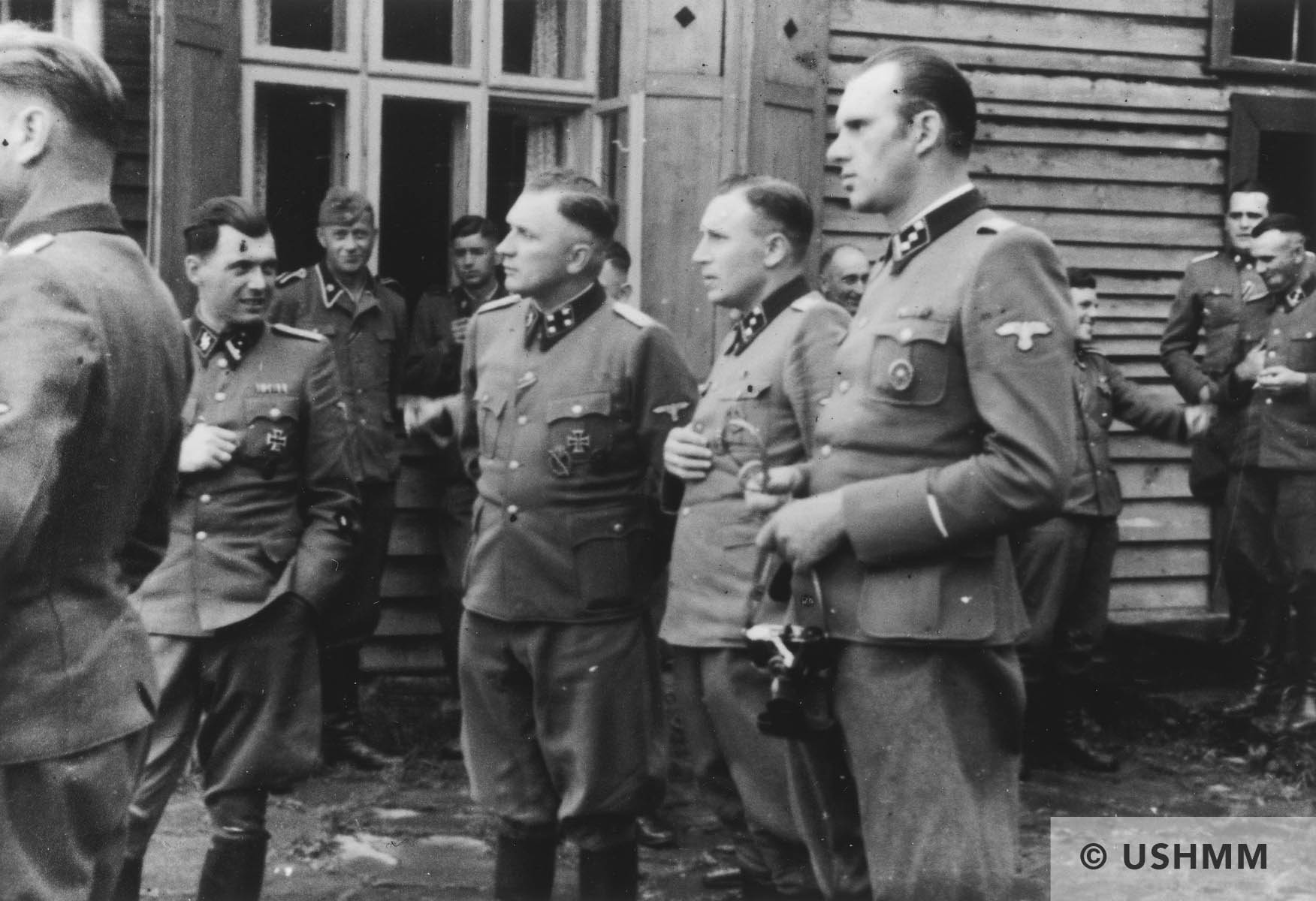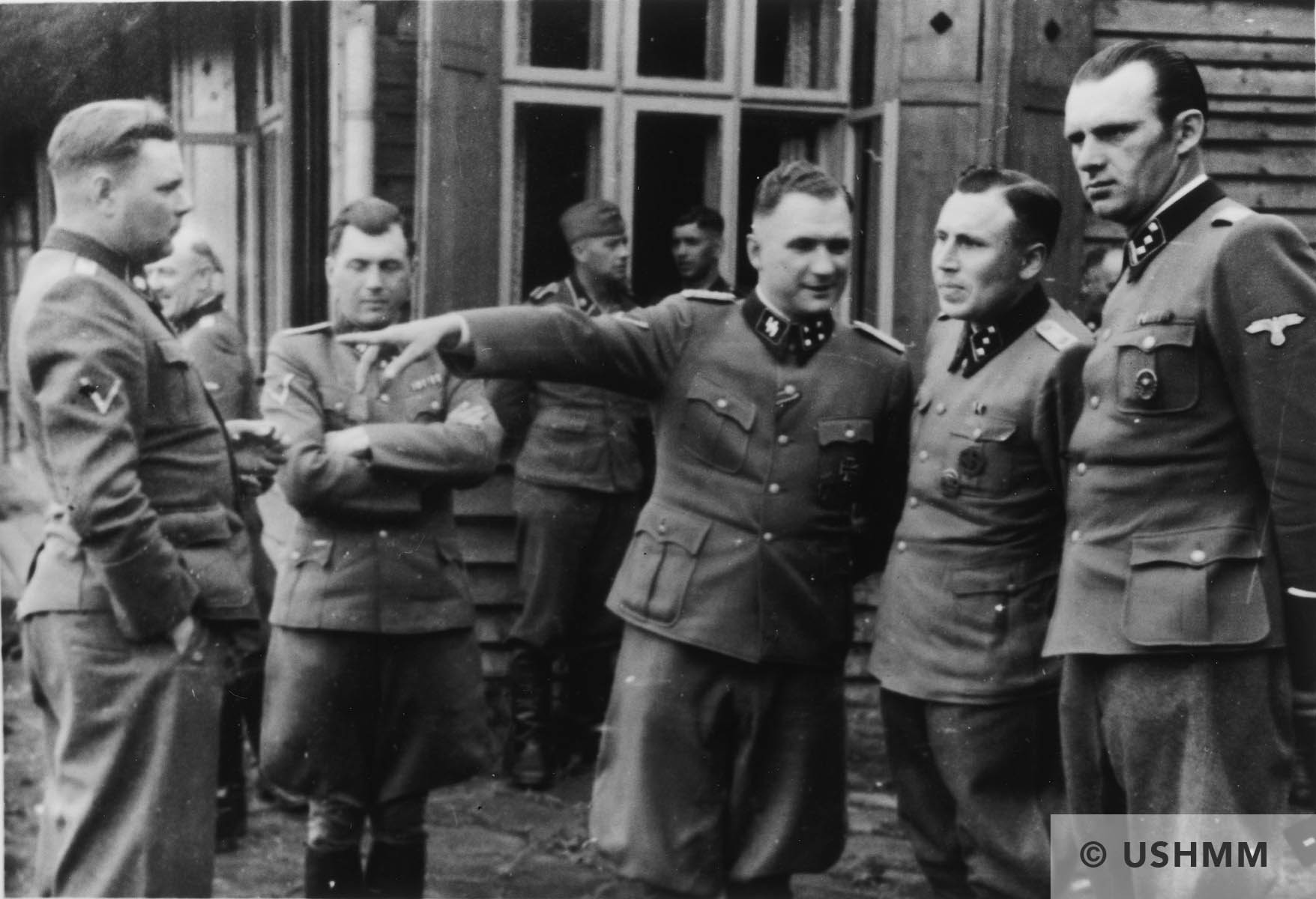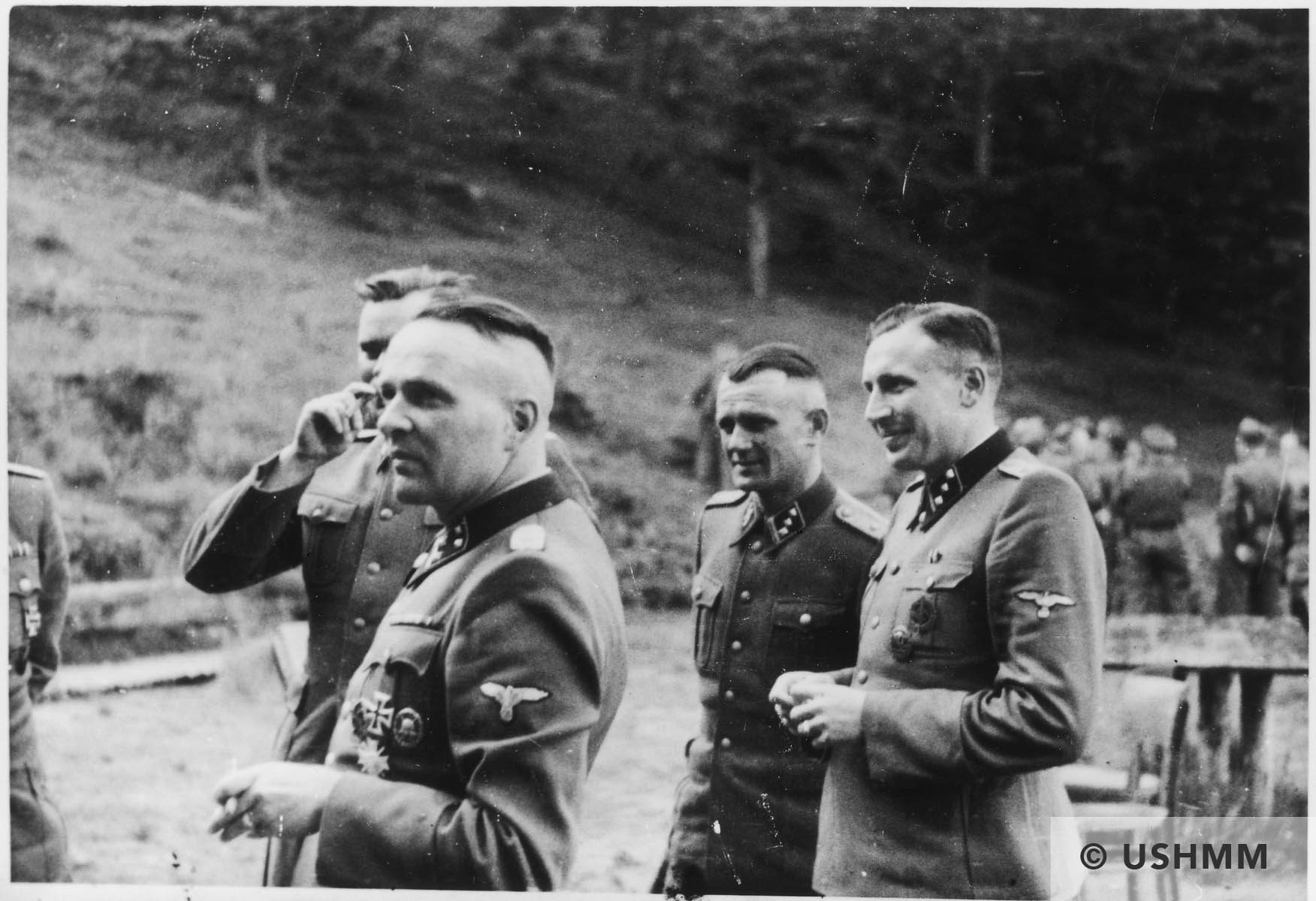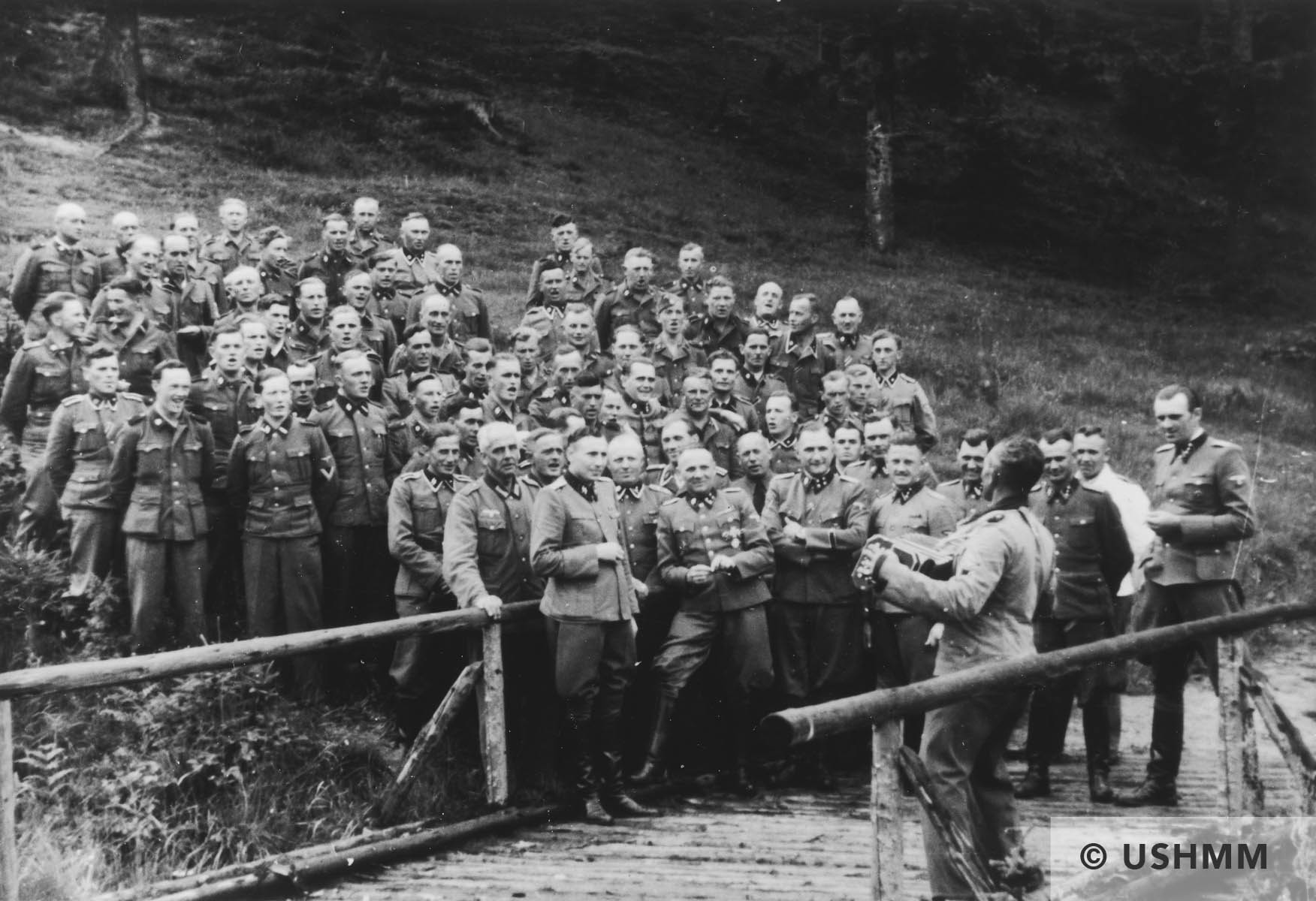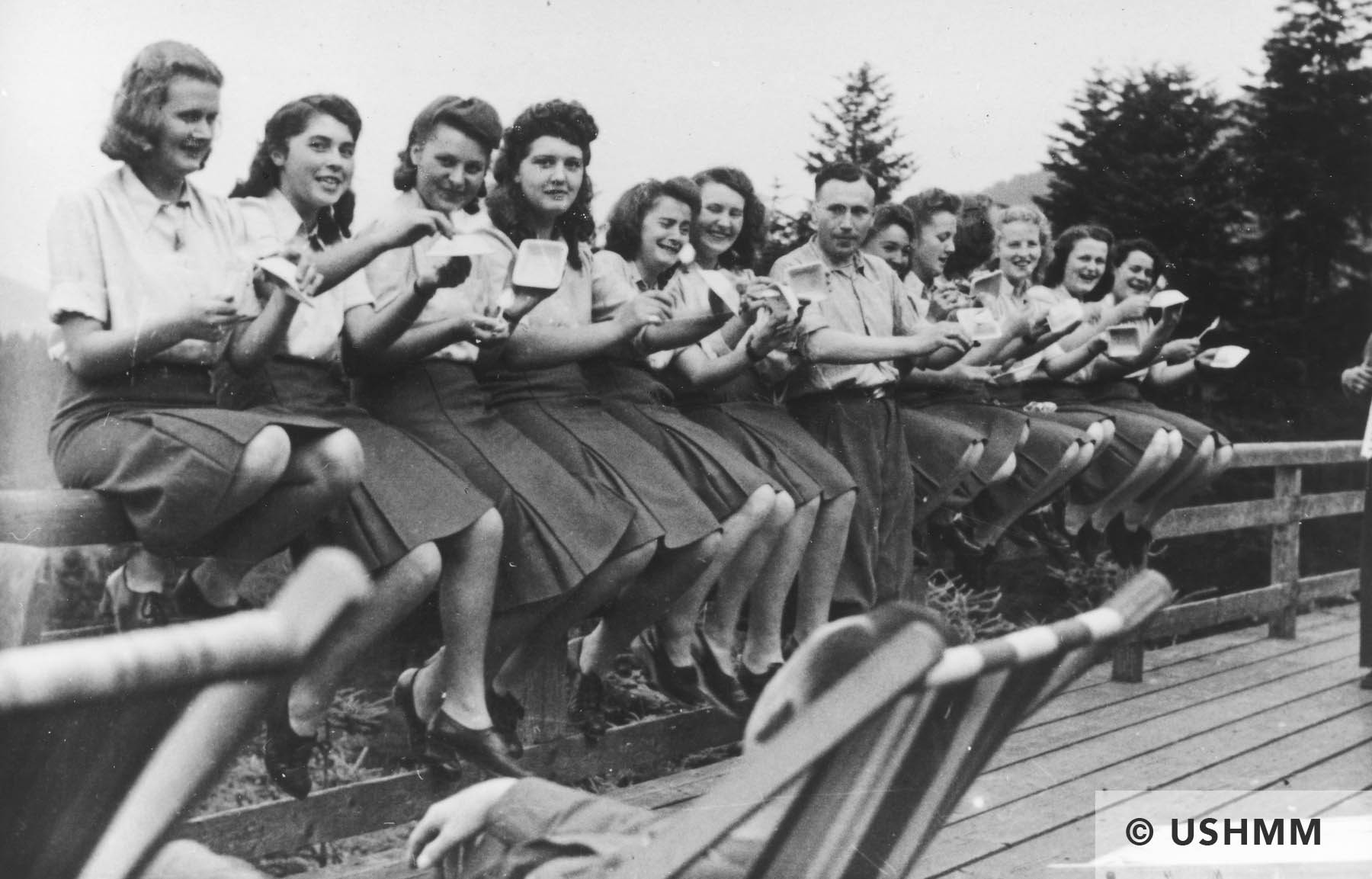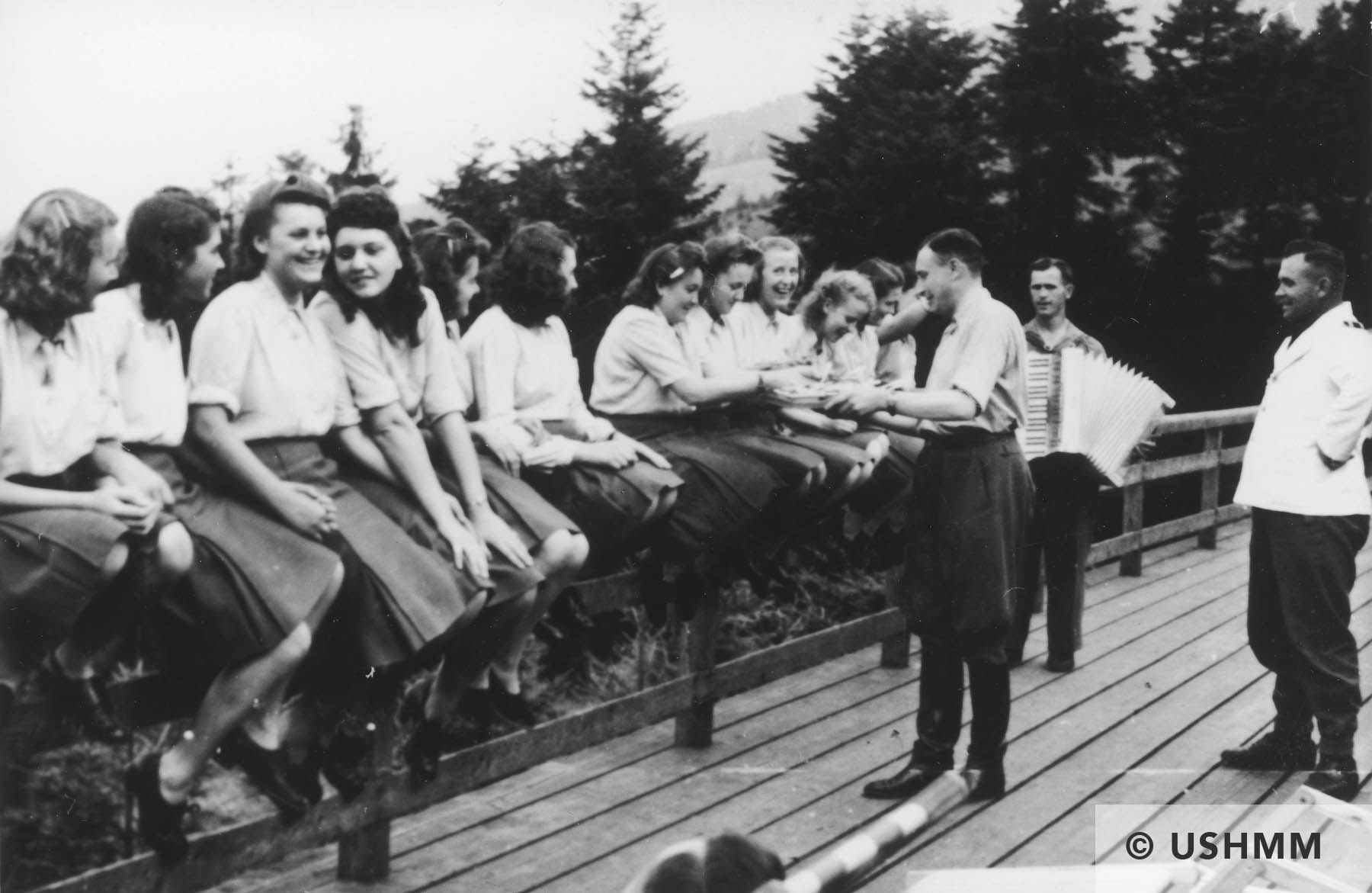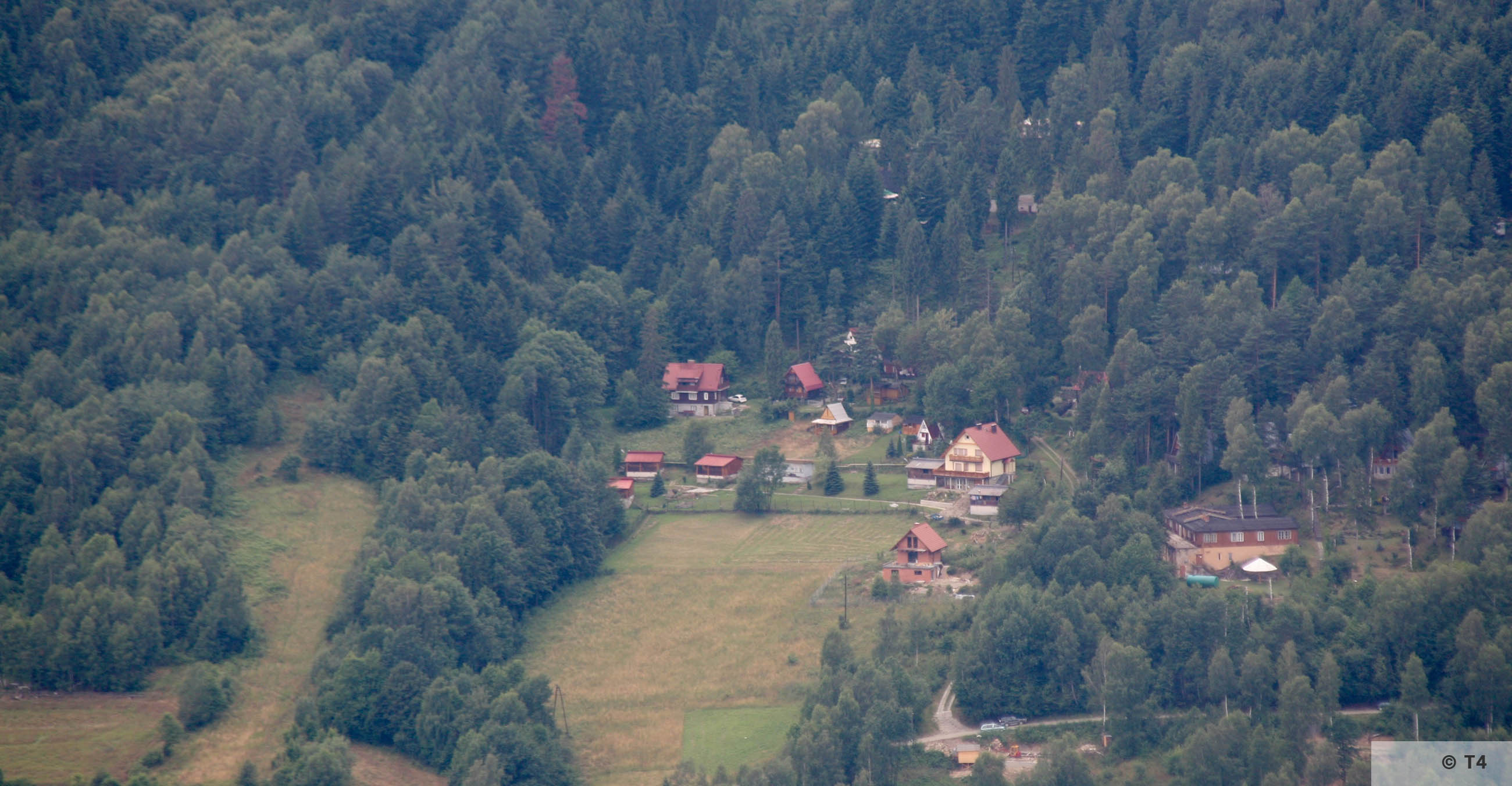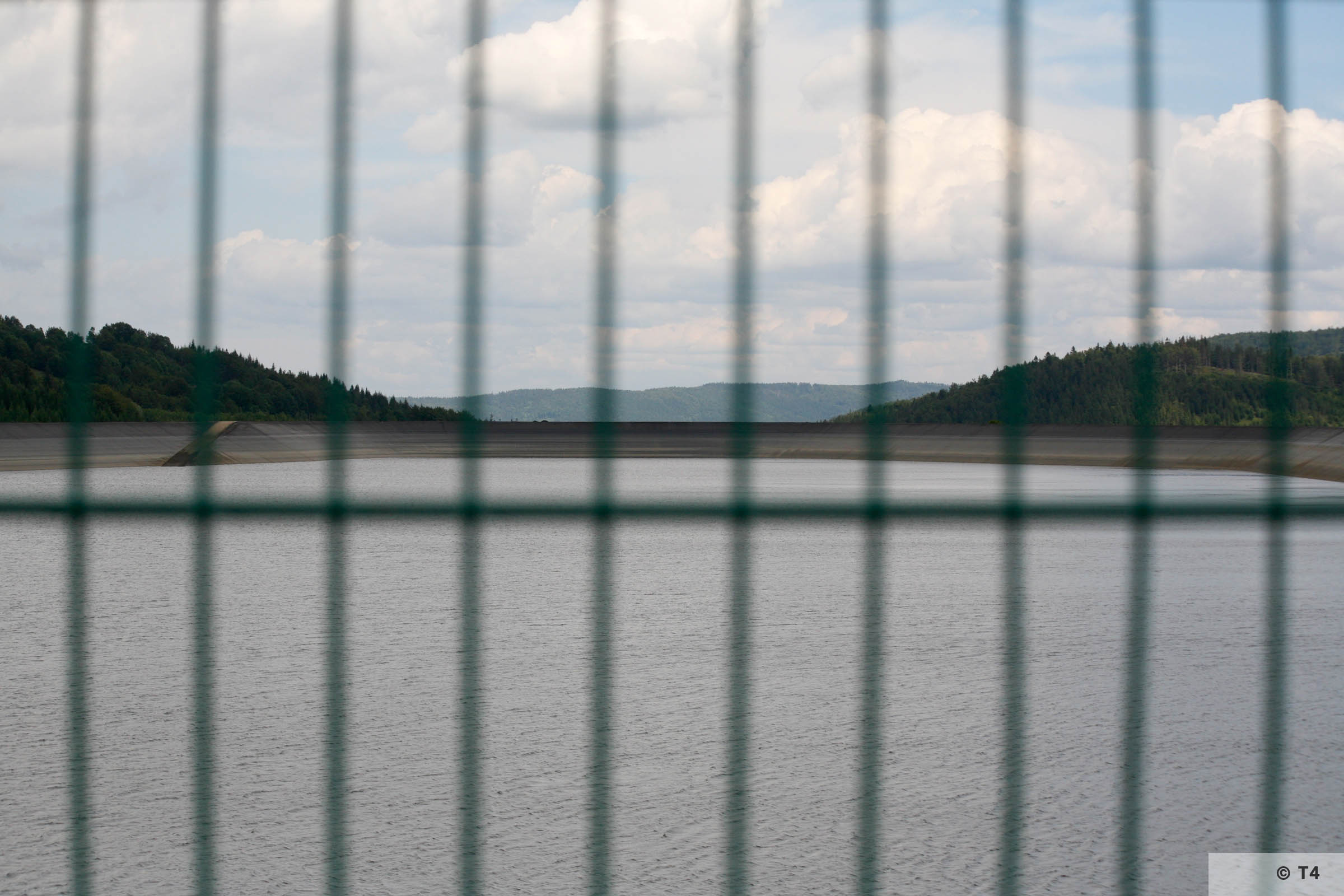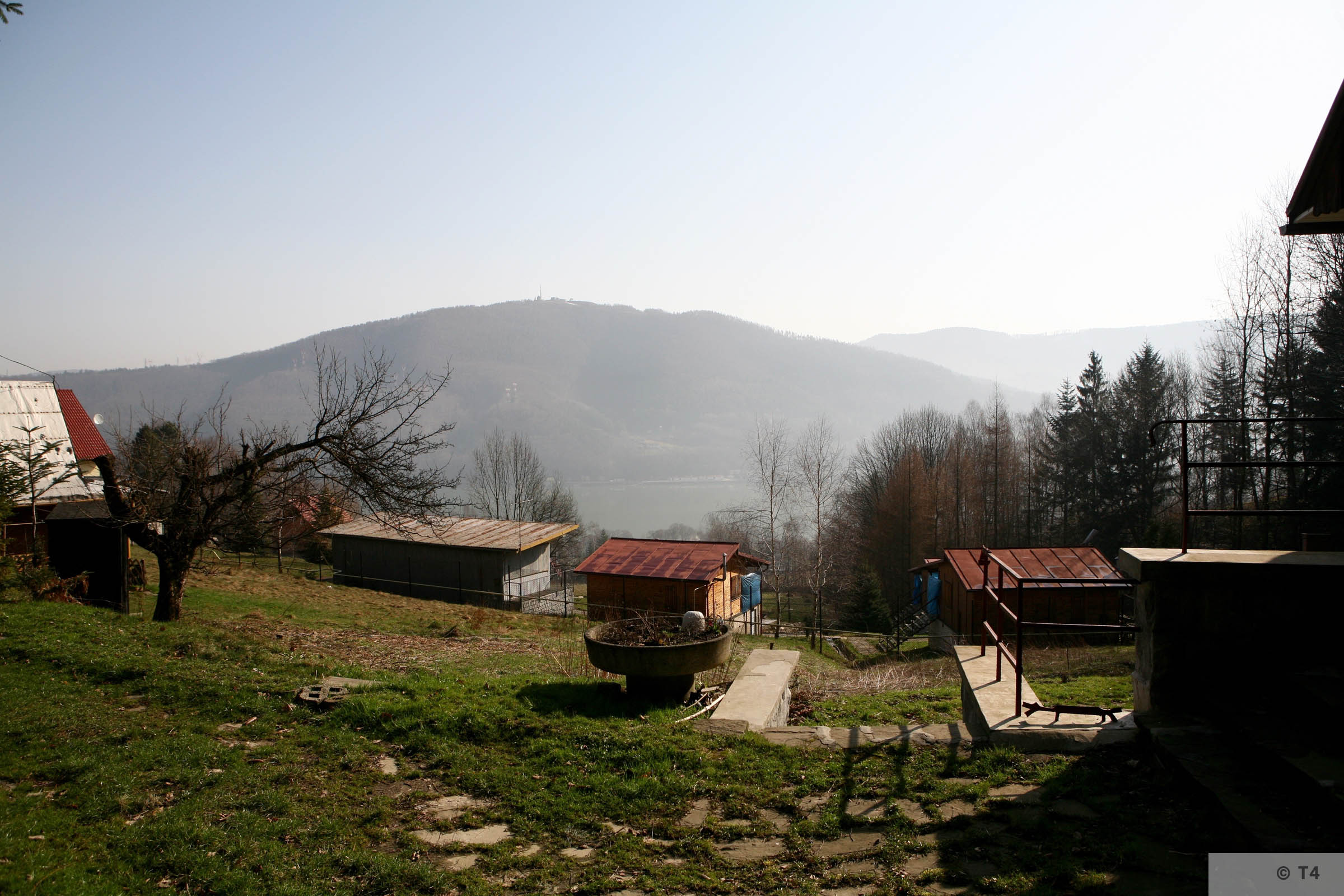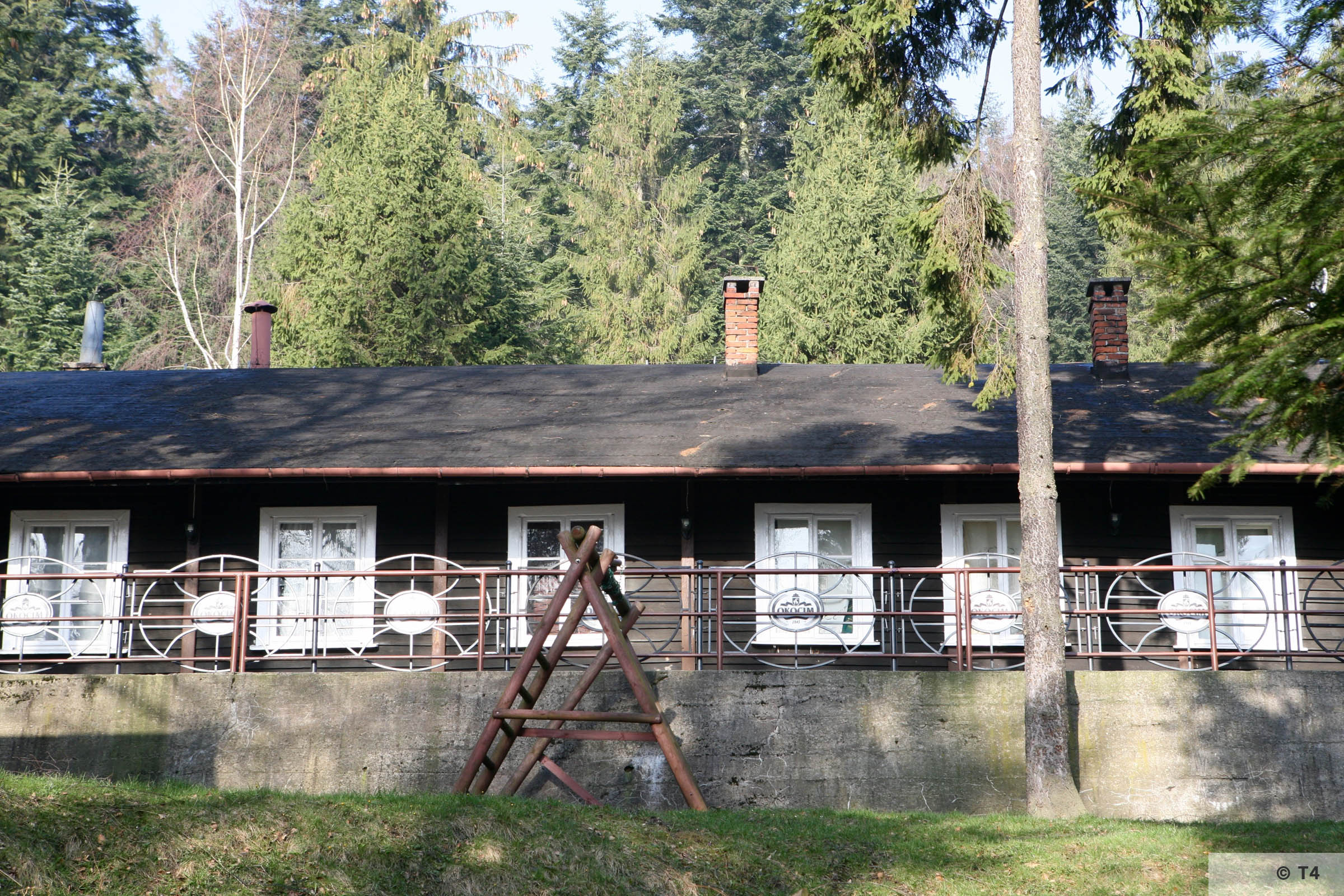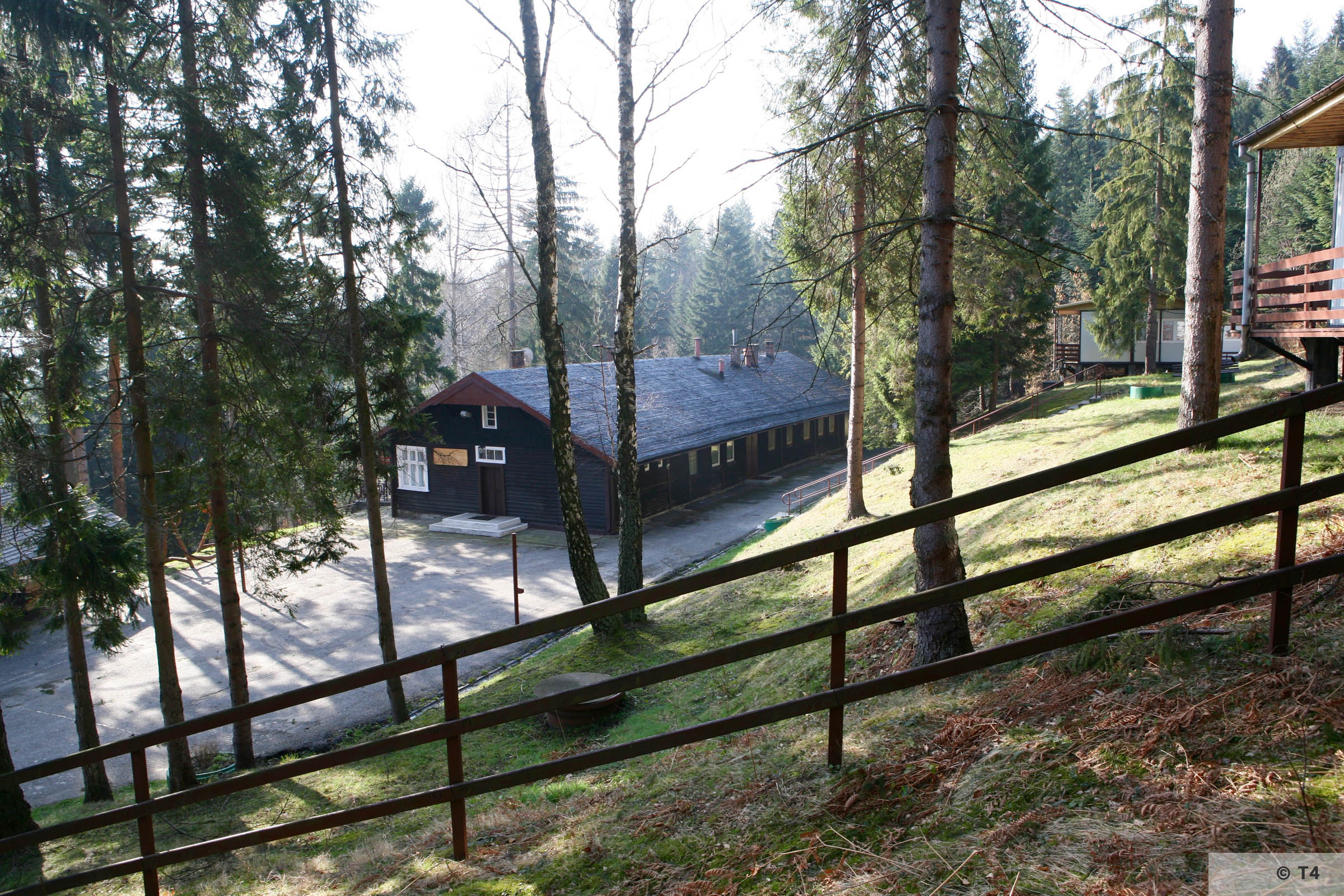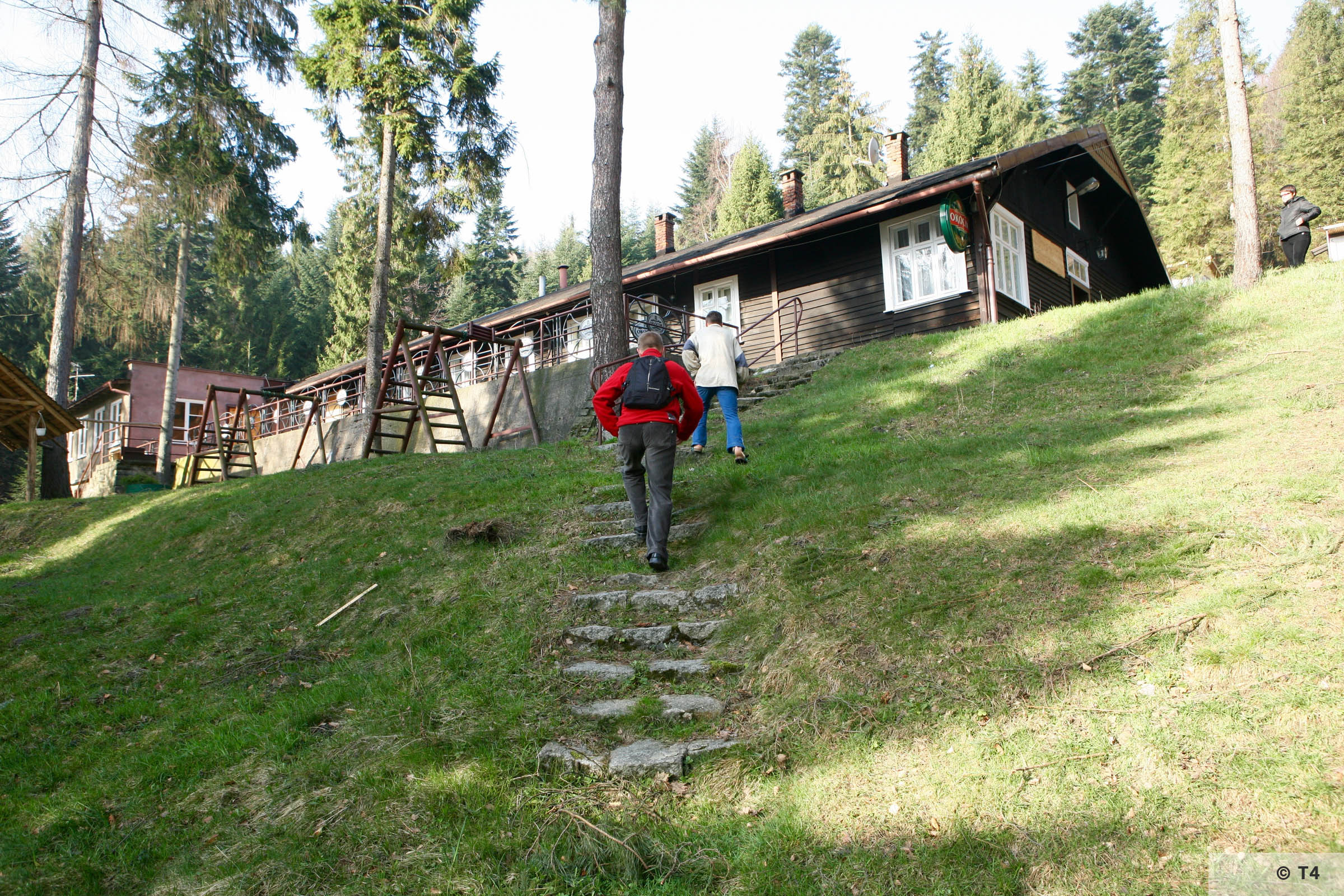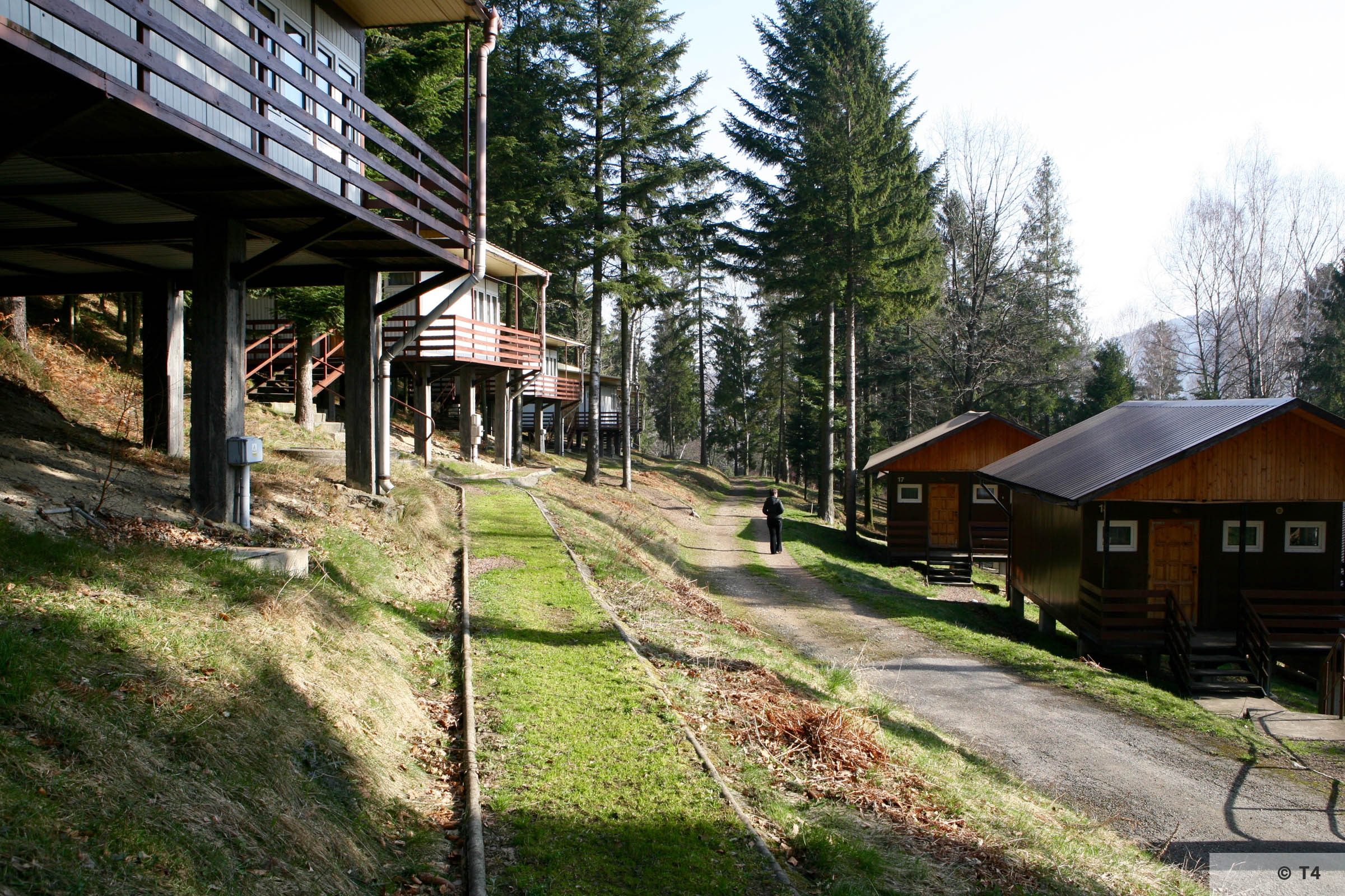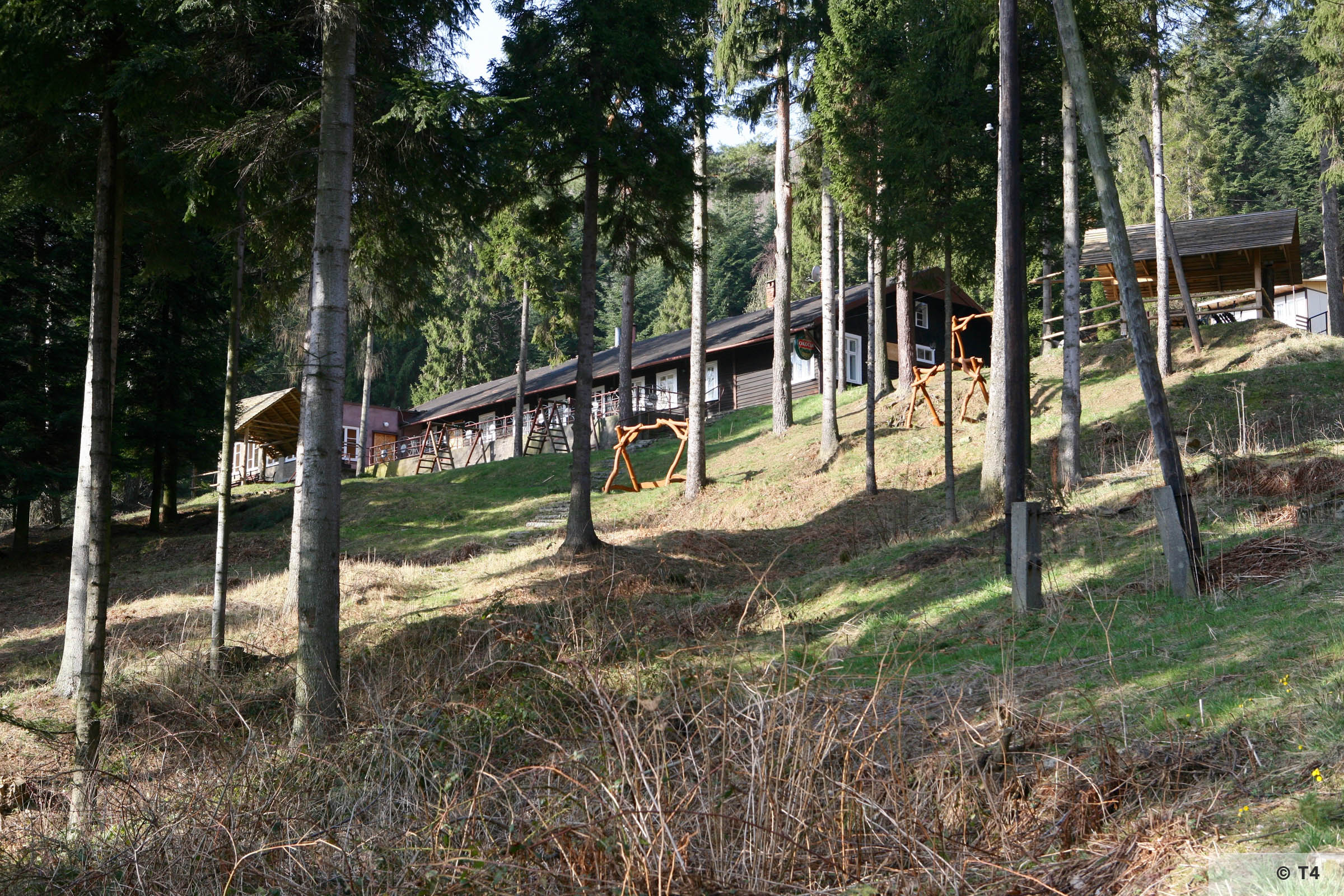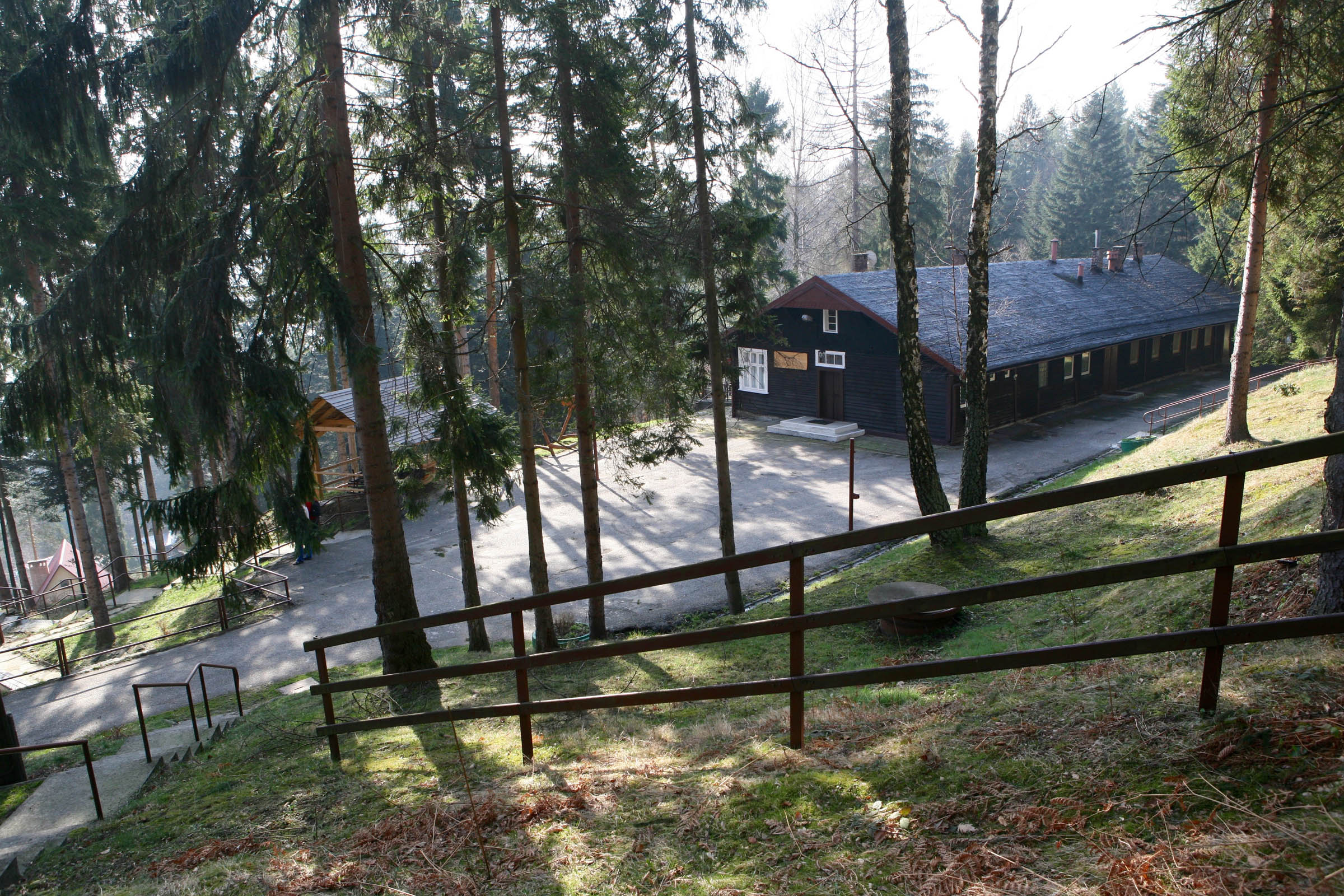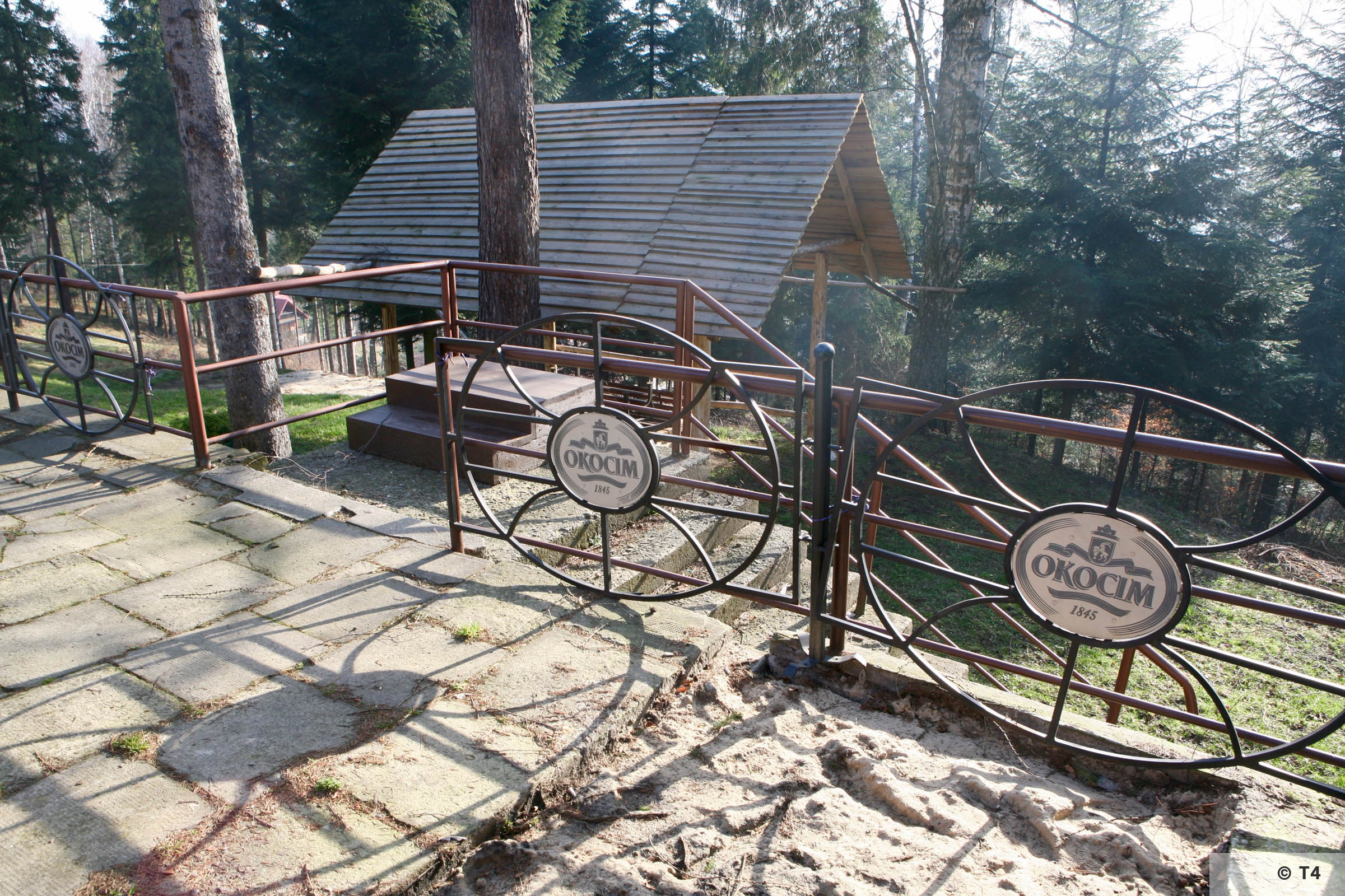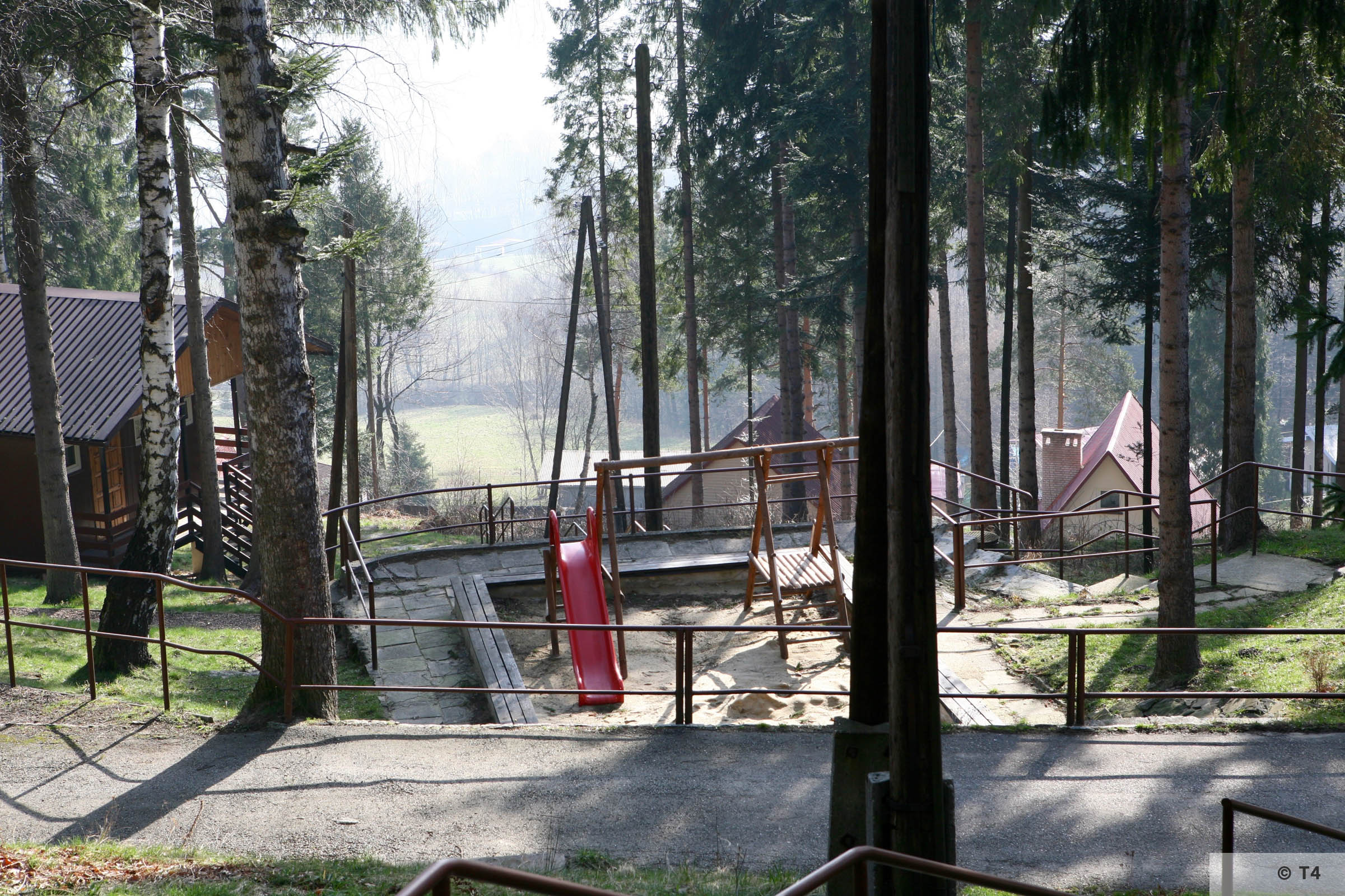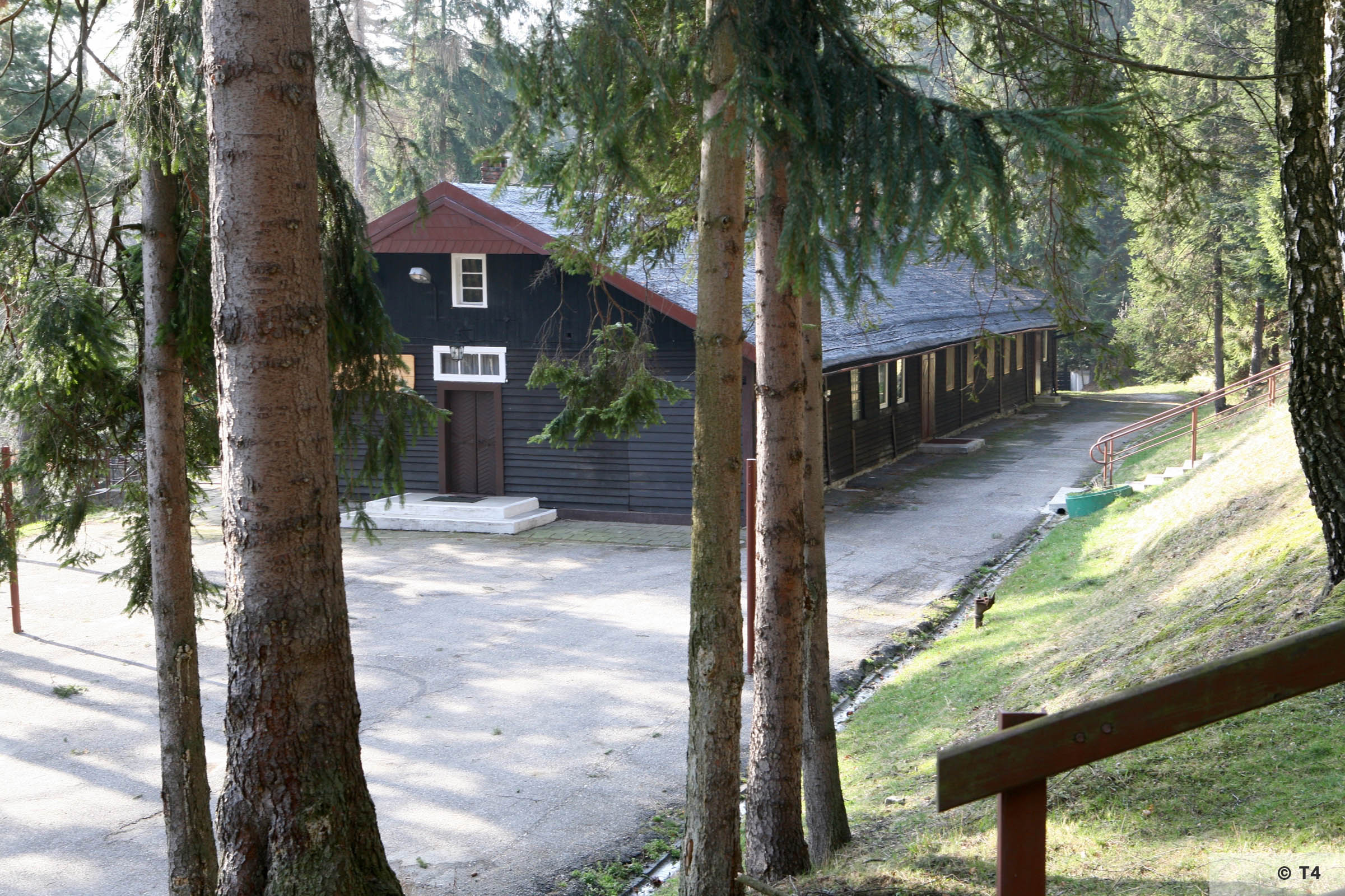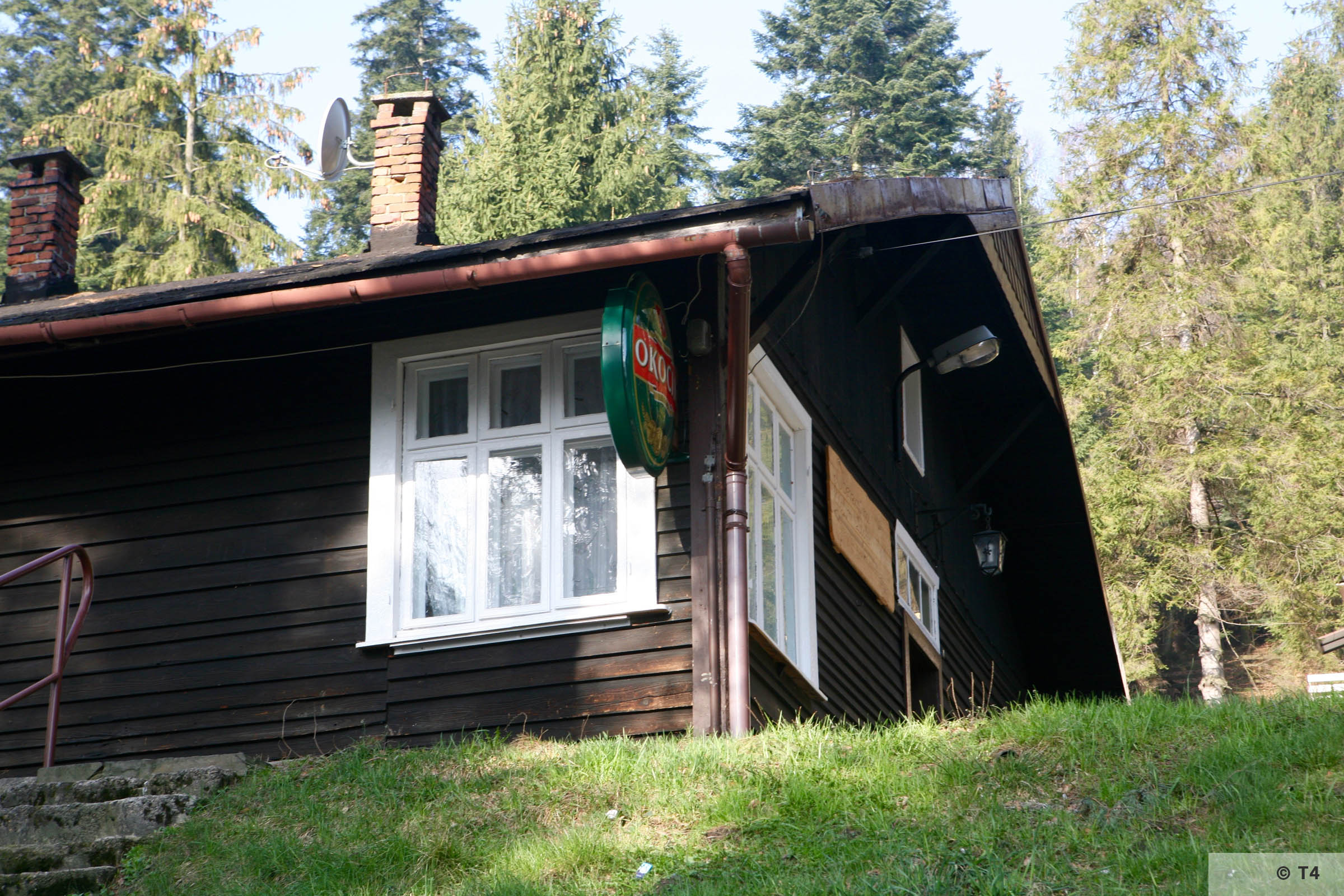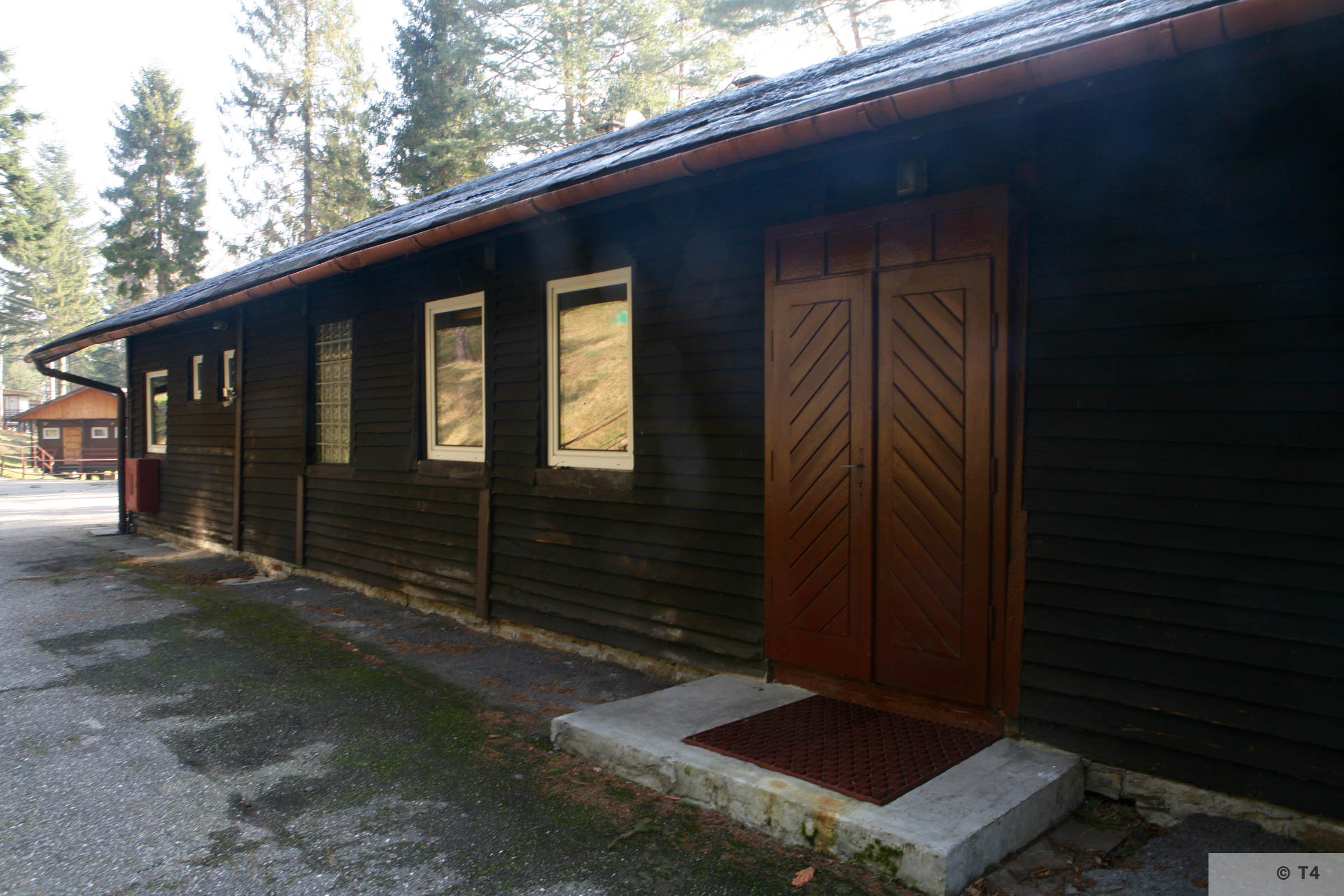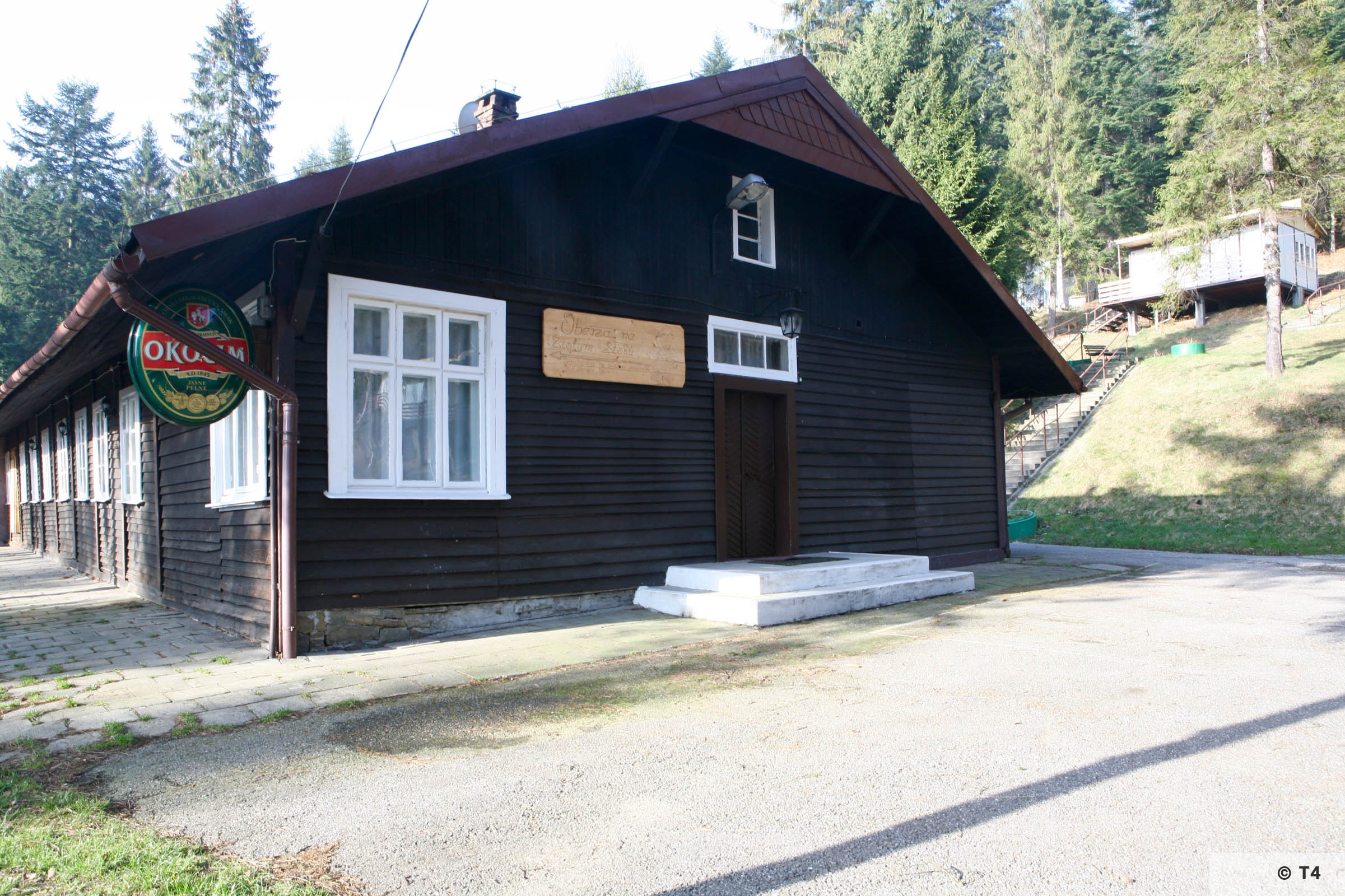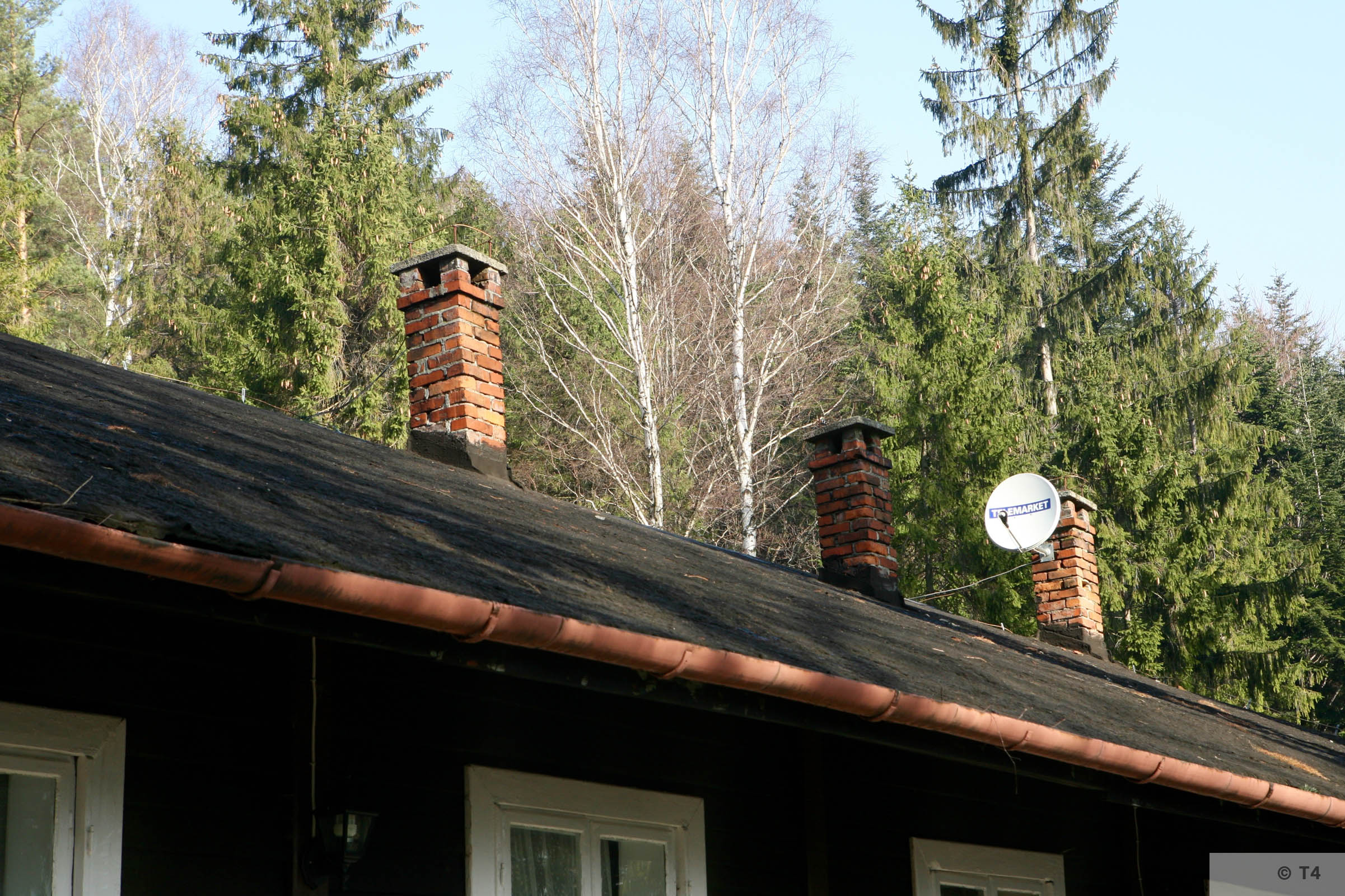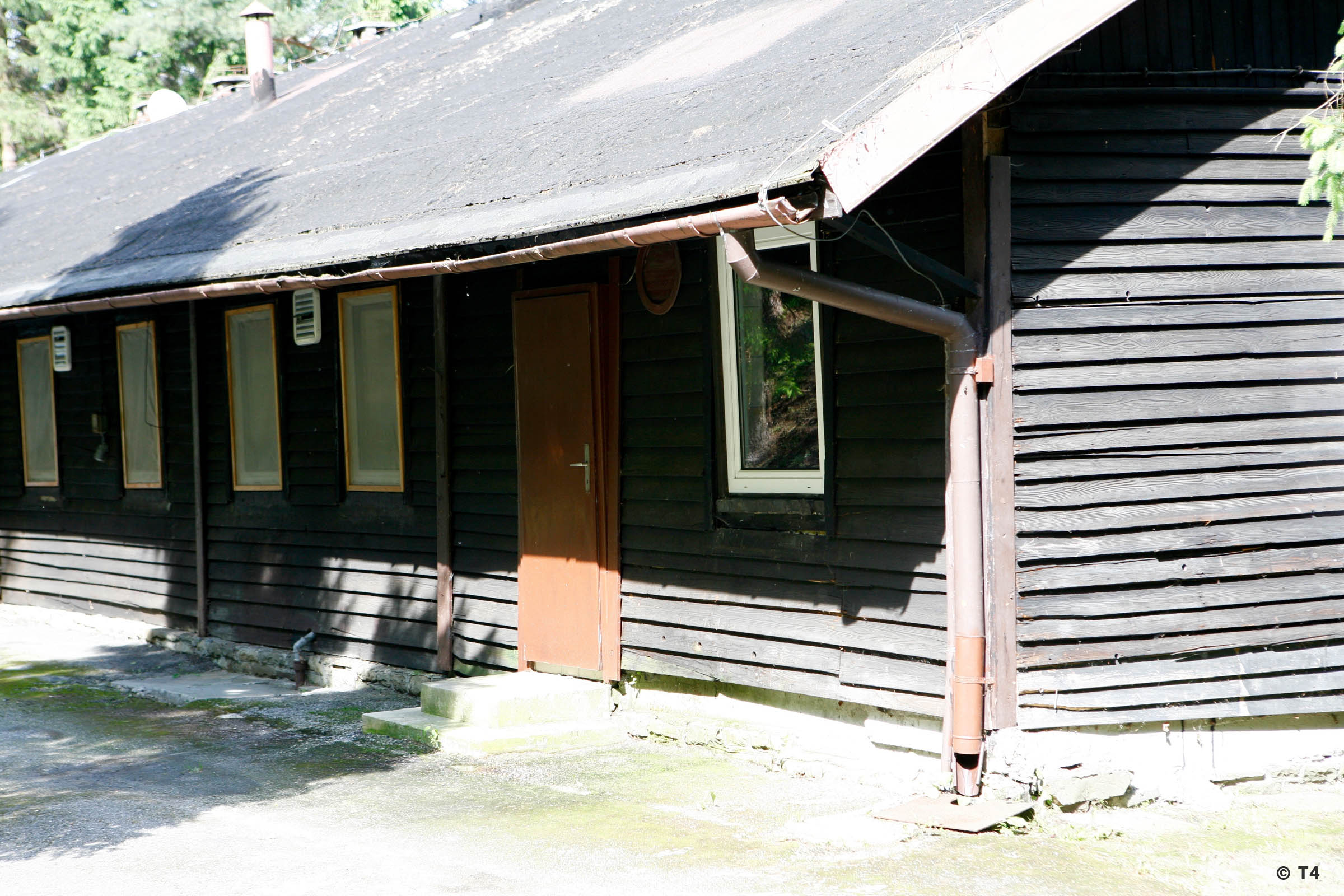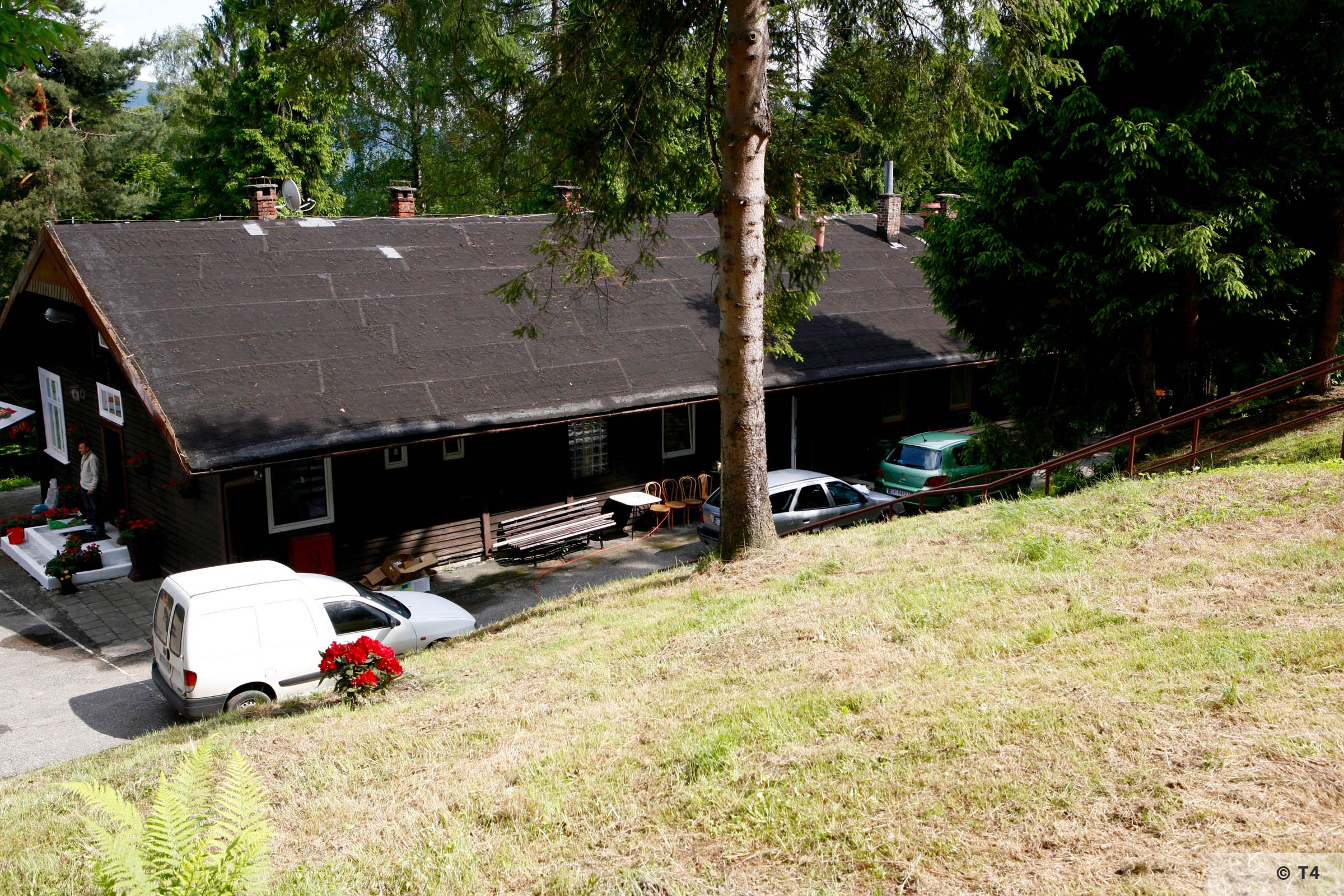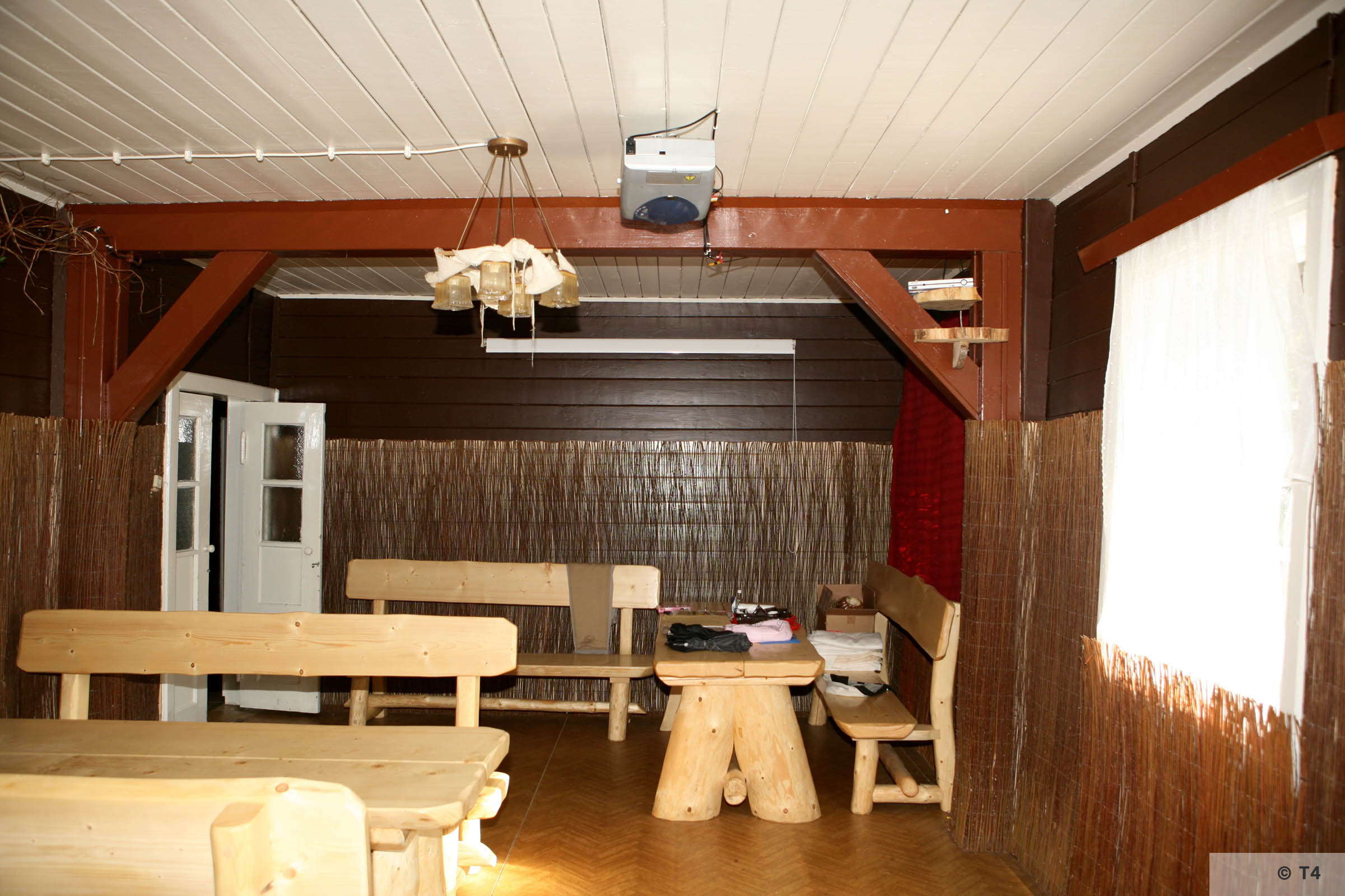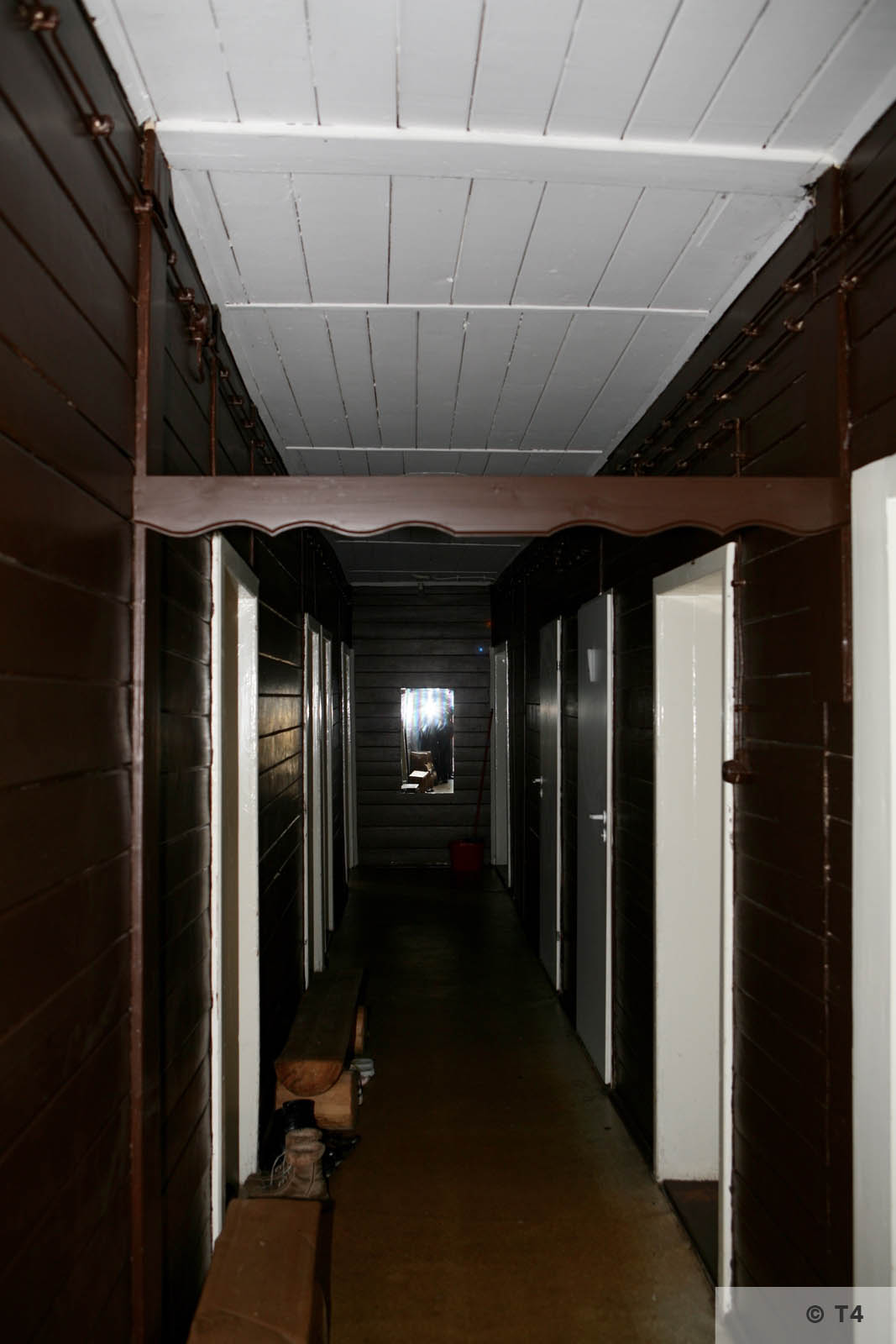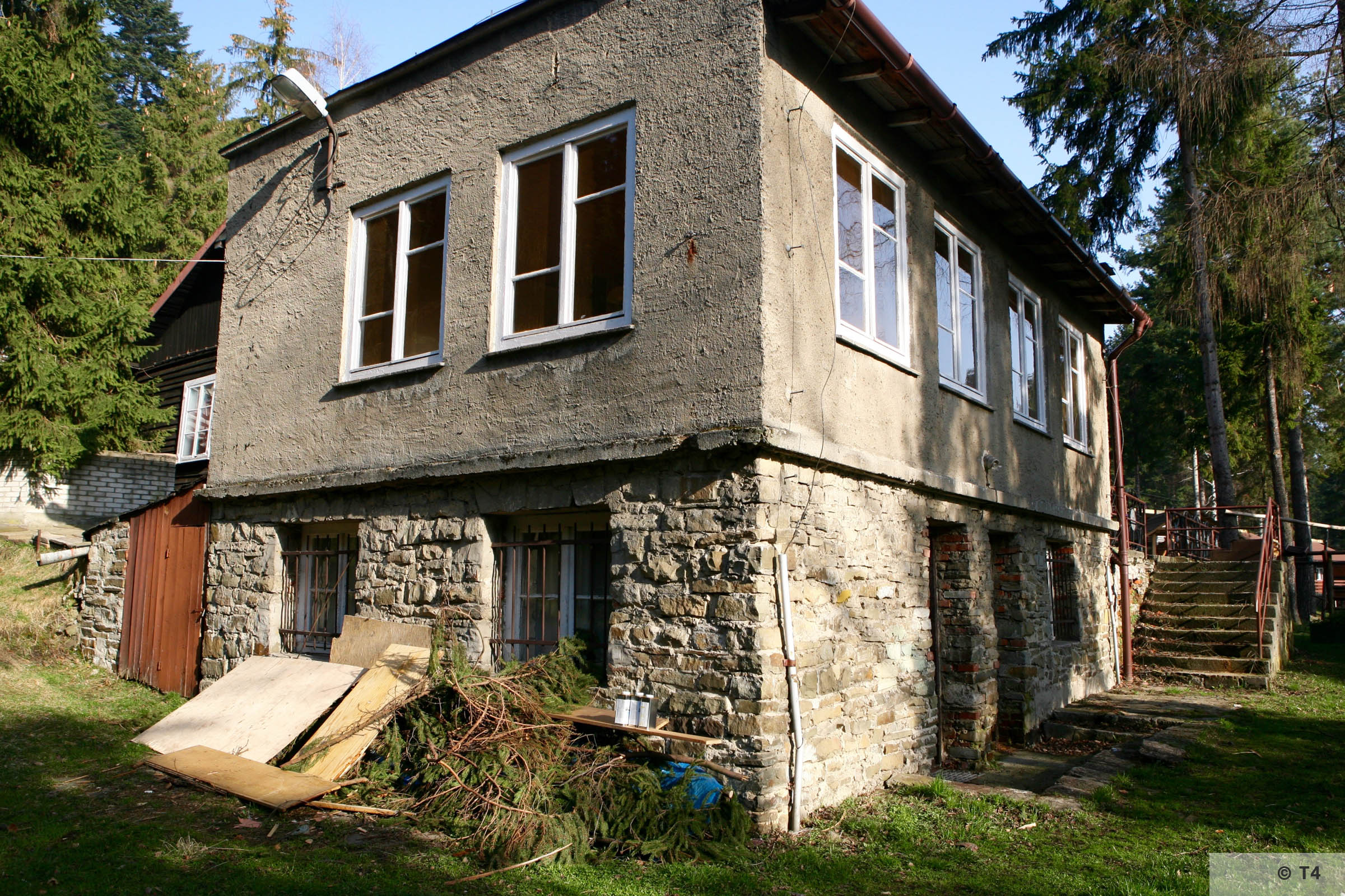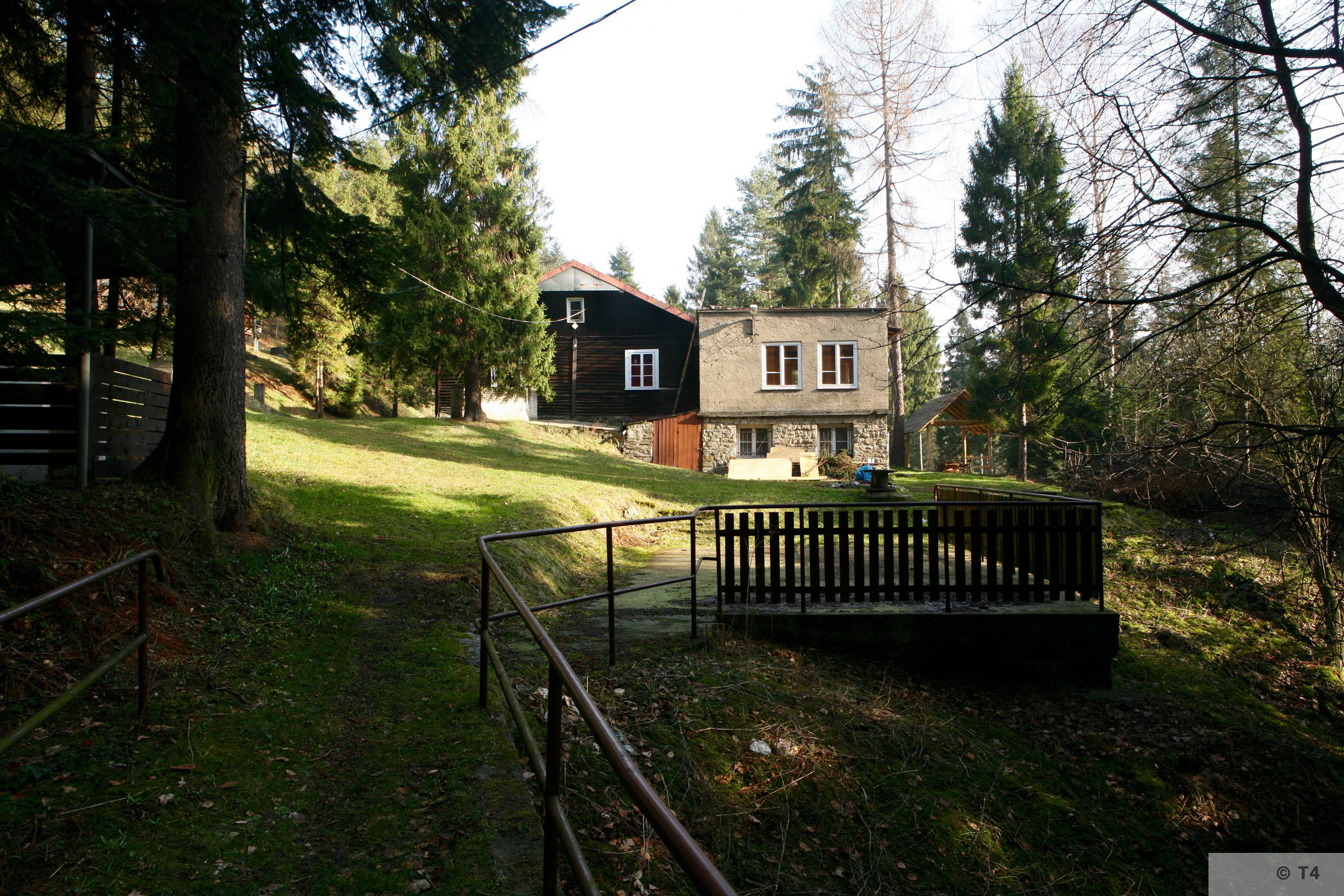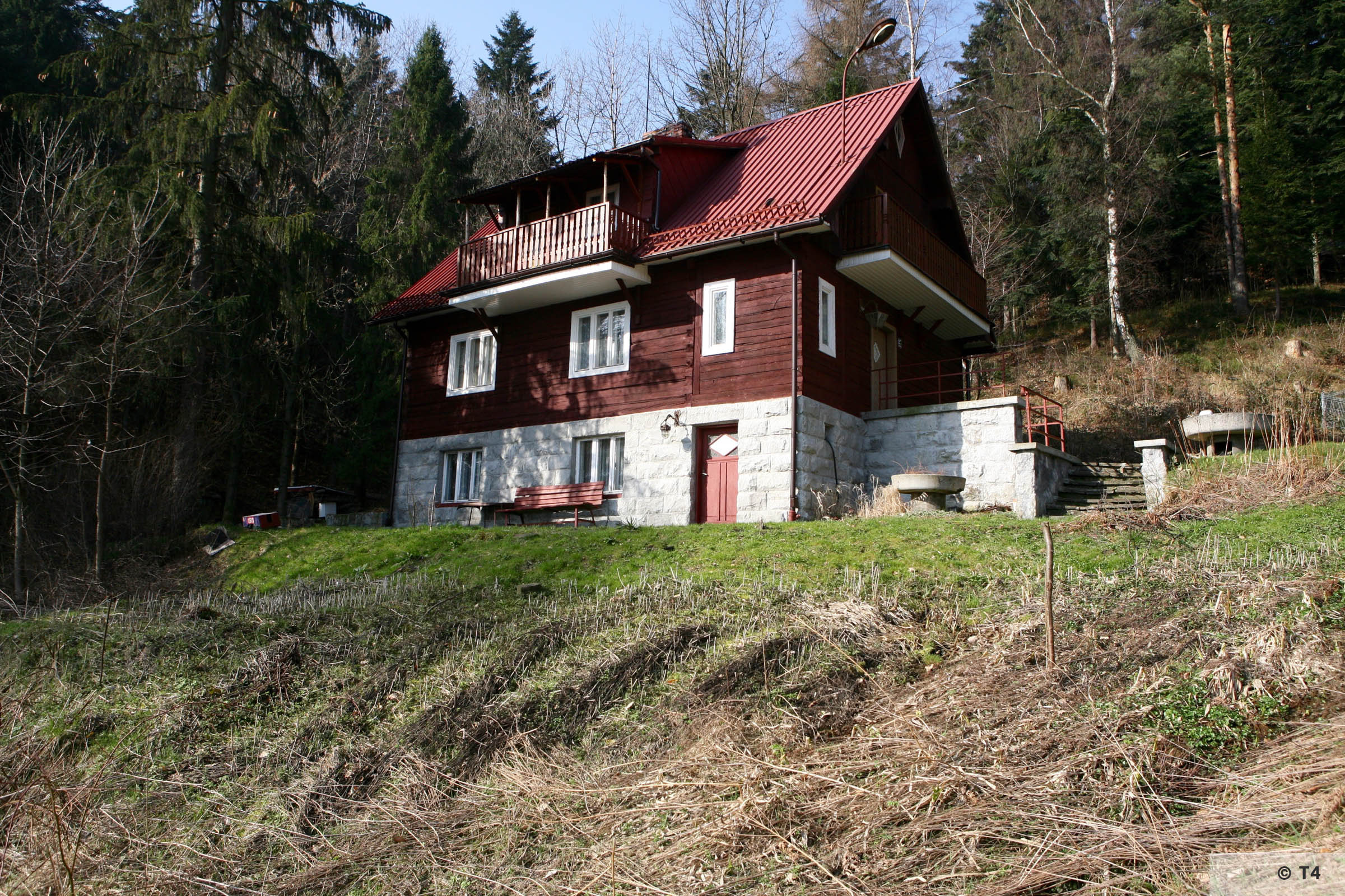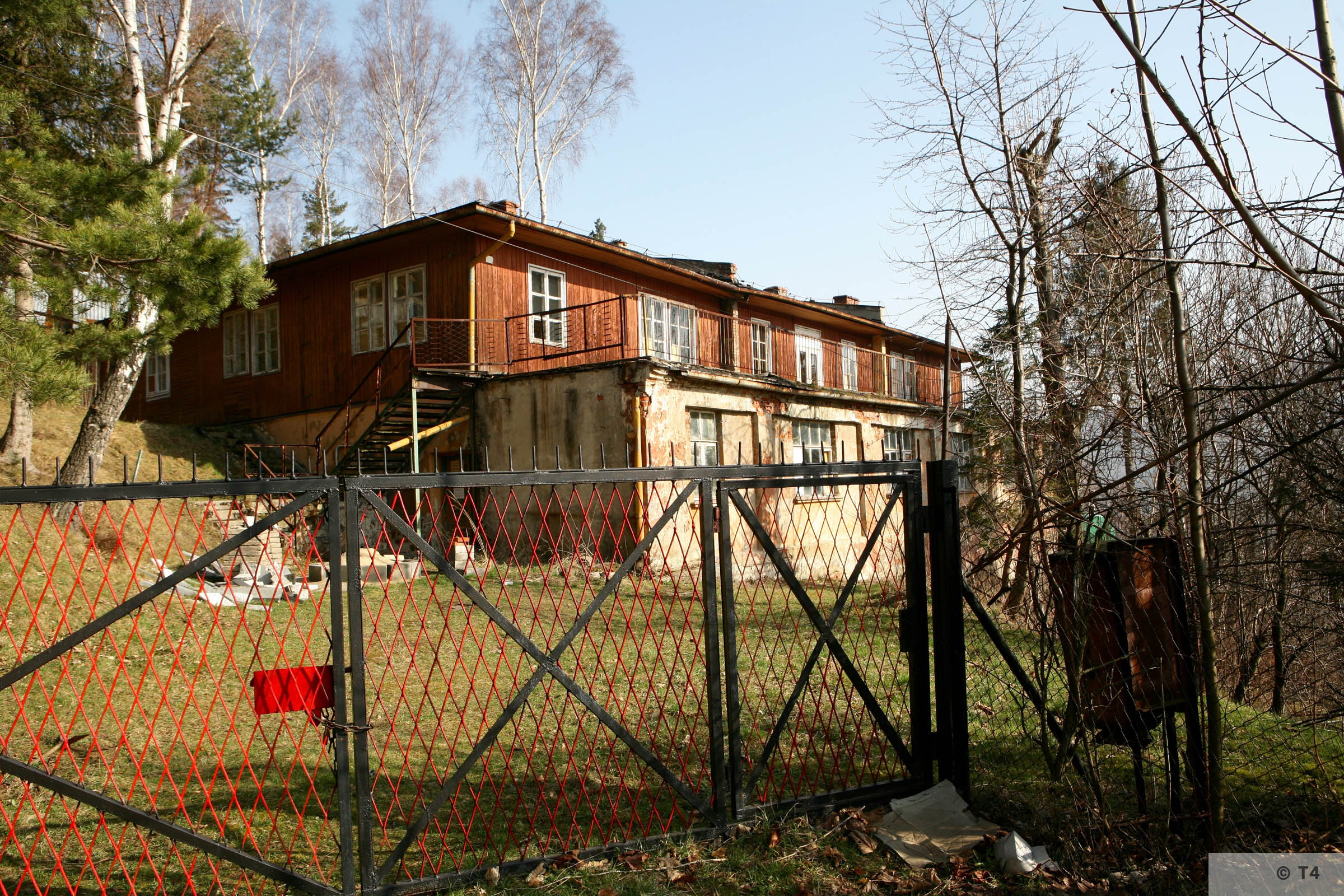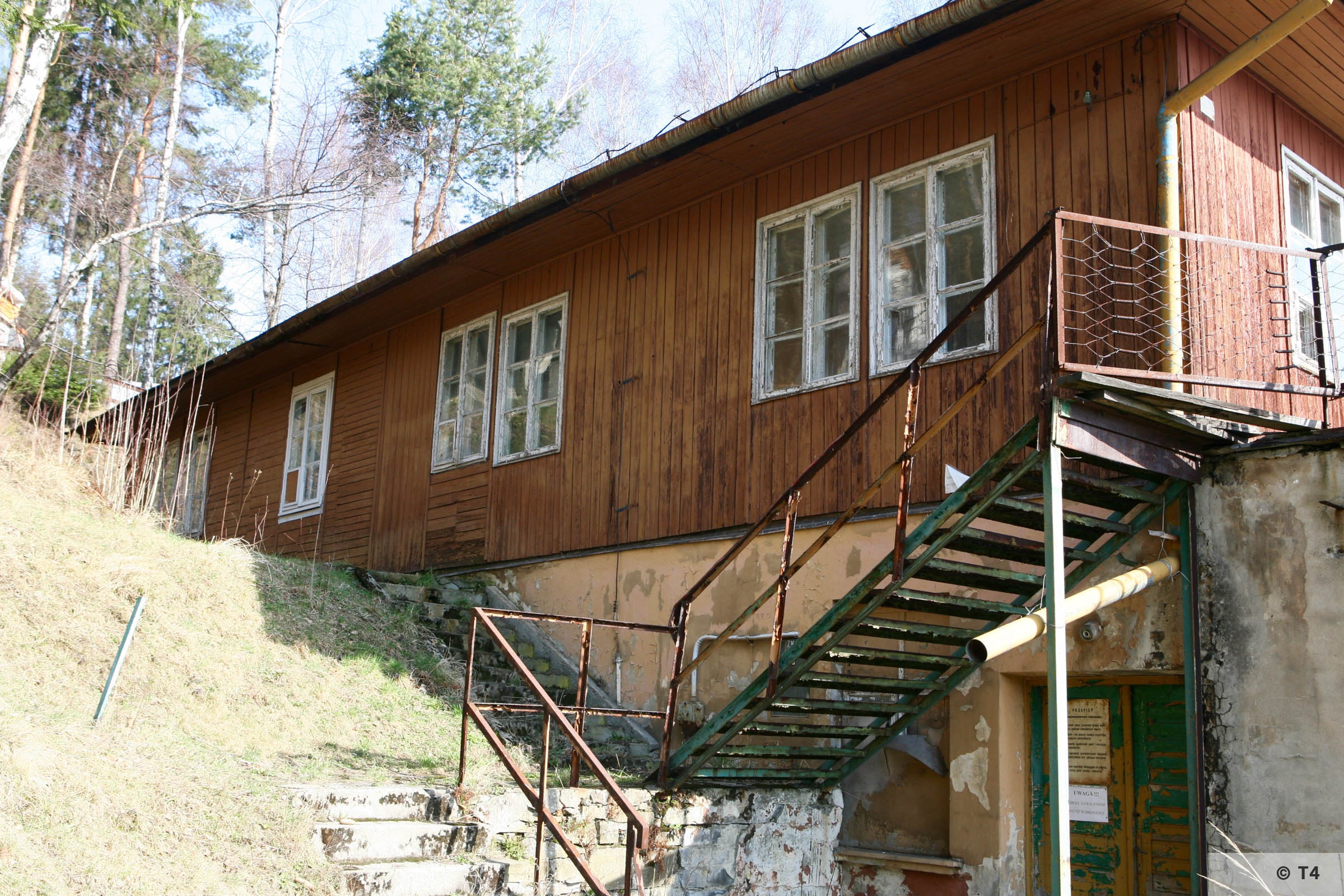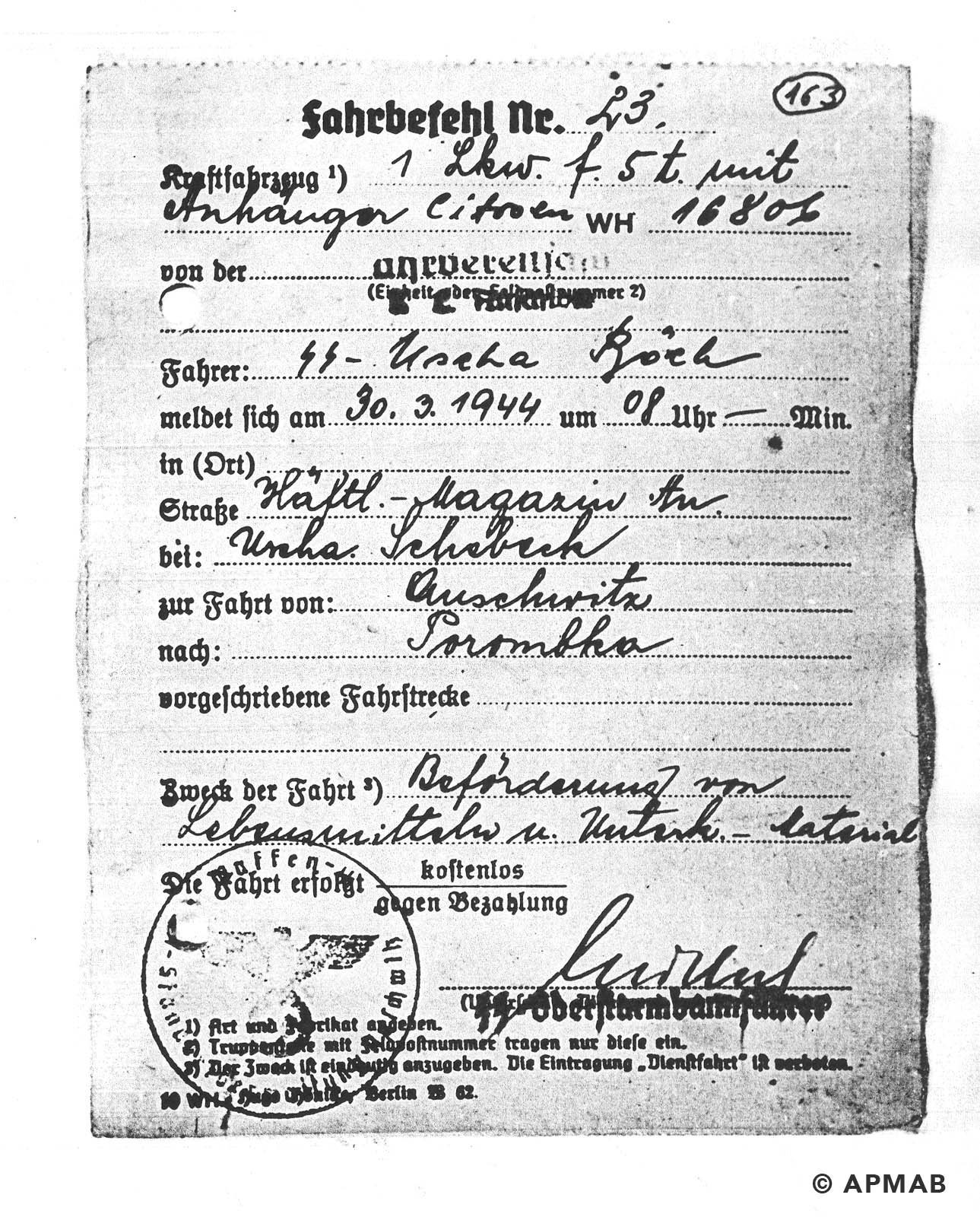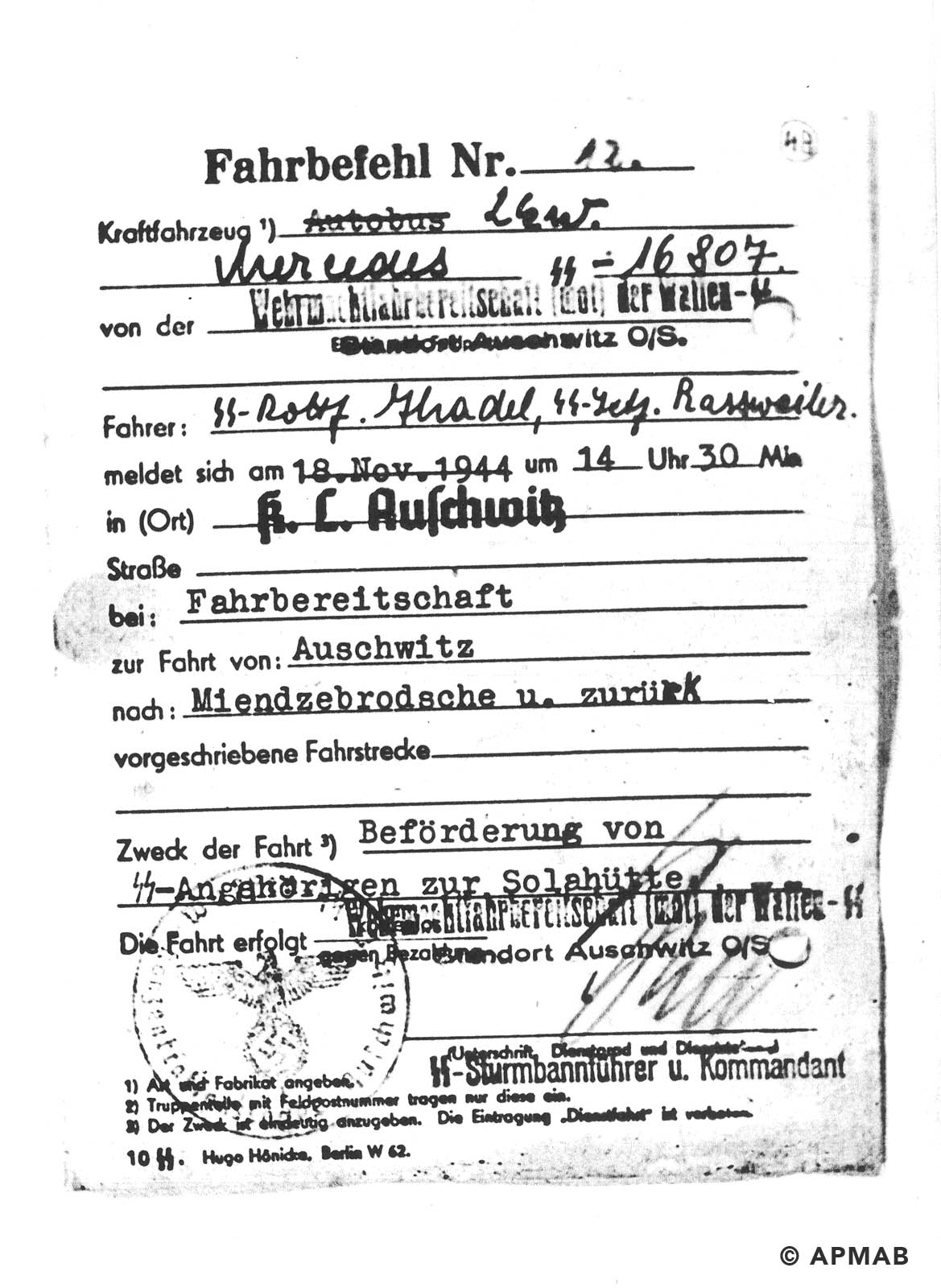SS Hütte Porombka
Other Name of the camp
Solahütte
Porąbka
Soletal
Commandant of the camp
SS-Oberscharführer Franz Hössler
SS-Unterscharführer Leo Rummel
SS-Oberscharführer Georg Ritzinger
SS-man (?) Niedermeier
Number of SS Guards
Initially 8 SS men.
Work type
SS Kommandos: Construction and staffing of an SS vacation home.
Employer
Auschwitz concentration camp
Sub camp buildings
Most of the buildings were built by the prisoners of Auschwitz I. An existing house was used to accommodate the prisoners. The prisoners were later accomodated in the SS Casino.
Number of prisoners
Between 20 and 40 male prisoners in the construction phase. Approximately ten female prisoners during its operation as a vacation home. Also 15-20 male prisoners on an ongoing basis transported fuel and supllies to Solahütte and undertook sundry repair works.
Nationality of prisoners
The first prisoners who constructed the camp were probably Polish political prisoners. The permanent staff of the vacation home were Jehovas Witnesses possibly German.
Period of camp existence
Autumn 1940 to January 1945
Dissolution / Evacuation of the sub camp
January 1945
Dates of site visits by Tiergartenstrasse4 Association
July 2006, March 2007, July 2007
Memorialisation
No known memorial.
Explore more
The History
The history of the companies and the places prisoners worked, the sub camps, the SS guards and memorialisation of the sites.
The History of the SS Hütte Porombka
SS Hütte Porombka, also named Solahütte, was not a typical sub camp of Auschwitz. There was none of the typical camp infrastructure in the form of barracks, electrified barbed wire fences or guard towers. It rather took the form of an Aussenkommando. Nevertheless, SS Hütte Porombka is included in the literature on Auschwitz sub camps, as are the two other Aussenkommandos, Aussenkommando Chelmek and Aussenkommando Sosnica as prisoners were permanently housed at the work location.
Documentation on SS Hütte Porombka is scant, although in the course of work carried out by Tiergartenstrasse4Association and employees of the Auschwitz-Birkenau State Museum, important new facts were discovered about the history of this small sub camp. The photographs collected in the album of SS-Obersturmführer Karl Höcker, adjutant of the commander of Auschwitz and SS-Sturmbannführer Richard Baer, depicting the SS at leisure in SS Hütte Porombka were an important discovery by the United States Holocaust Memorial Museum (USHMM). This album sheds light not only on what was happening at SS Hütte Porombka, but also on how the SS men from Auschwitz spent their free time.
The album known as the Höcker album was donated to the USHMM in January 2007 by an American counter-intelligence officer, who wished to stay anonymous. The album contains 116 black-and-white photographs, depicting mostly SS officers from Auschwitz. On the first page it is signed: With the SS Commandant Stubaf. Baer, Auschwitz 06/21/1944. It has been established beyond doubt that the album belonged to SS-Obersturmführer Karl Höcker, adjutant to the commandant of Auschwitz, SS-Sturmbannführer Richard Baer. Evidence of this is not only the signed first page, but also the fact that Höcker is the only person who appears alone in some of the photos. Most of the photographs are from the summer of 1944, from the Solahütte vacation home for Auschwitz SS camp members. The second group of photographs comes mainly from the area of the SS hospital, located in the immediate vicinity of the Auschwitz II-Birkenau.
The History of the Sub Camp SS Hütte Porombka
SS Hütte Porombka was the second (after Aussenkommando Sosnitz) sub camp founded by the commandant of Auschwitz. It was one of the most unusual sub camps of Auschwitz, in that it was established to construct and operate a vacation home for members of the Auschwitz concentration camp staff.
SS Hütte Porombka was established at the beginning of October 1940. Before a permanent on site Kommando was established, prisoners were brought to work for the day from the Auschwitz main camp, and in the evening they were transported back.[1] Soon, however, these daily transports were abandoned as inefficient and it was decided that prisoners should be accommodated on site at the proposed vacation home. Originally, about 20 prisoners were selected for the construction of the vacation home, later this number was increased to around 40. Eight SS men were assigned from Auschwitz, headed by Kommandoführer Franz Hössler. [2] .
The place chosen for the location of the future holiday home was Międzybrodzie Bialskie, about 35 km south of Oświęcim. Międzybrodzie Bialskie is located in the centre of the Little Beskid mountains, above a dam and artificial lake, and was the perfect location for a place of relaxation.
The SS decided to build the holiday home on a fairly steep slope of the Rogacz mountain which provided a panoramic view to the nearby mountains and the lower artificial lake.[3]
Prisoners employed in the construction of the holiday home were accommodated in the basement of a house located on the slope below the construction site. Artur Rablin a former prisoner testified, “There were about 50 prisoners working there with me – all of them Polish – and we all lived in a basement situated under some villa.” [4] SS men lived on the ground floor and upper floor of the house. The cellar windows were barred, and the SS men stood guard around the house and on the construction site.[5]
The first group of prisoners from the Auschwitz concentration camp included:
- Stefan Krawczuk
- Konstanty Krawczuk
- Bogdan Sawczuk
- Zbigniew Zasadzki
- Paweł Gacki
- Ludwik Kubacki
- Józef Podeszwa
- Marian Mykała
- Jan Lupa Nr. 63
- Franciszek Kmak
- Tadeusz Orłowski
- Roman Pociecha
- (?) Gabryś
- (?) Galas (Kapo)
- (?) Winand
- Władysław Gut, zam. Sanok [6]
A Polish prisoner Edward Liszka who arrived in Auschwitz on 19 December 1940 worked for a few days on the building of the SS vacation home. Also his friend Artur Rablin who arrived in Porąbka on 11 January 1941 and left on 2nd February 1941[7]. Liszka estimated that 50 prisoners were working at Porąbka. [8]
Prisoners were dressed in normal camp clothing – striped prison uniforms. The food for the SS and prisoners was prepared from supplies delivered from the Auschwitz main camp by truck. The prisoners building the vacation home complained of severe hunger.
The prisoners were divided into two working teams. Former prisoner Tadeusz Pietrzykowski, working in the first team responsible for unloading and transporting construction materials: “First, we unloaded the wooden beams next to the road, and then we had to carry the wooden beams and other building materials on our backs uphill, a distance of several hundred meters. I personally worked in a group of prisoners who carried 50 kg bags of cement on their backs. This already gives an idea of the enormity of the effort required of us prisoners, together with our malnutrition and rapid deterioration.” [9] Artur Rablin remembered, “In Porąbka, the prisoners would carry 50-kilogram bags up a steep hill; others would carry 80-kilogram cubes of pressed peat, buckets of sand, bricks, etc., and building materials such as roofing felt, beams…..”[10]
The second working team was responsible for preparing the area on which the foundations of the holiday home were to be laid. This work was also difficult, because the prisoners worked on the steep hillside of the Rogacz mountain, only with pickaxes. The work lasted about 12 hours a day.
In the first period of construction, the behaviour of SS men supervising the work was extremely brutal. There were often beatings by the SS guards and their dogs harassed the working prisoners. The situation was made worse by the weather. Autumn gave way to a particularly cold winter, which meant that the prisoners began to talk about themselves as those who had been sent there to be “finished off”. Some prisoners lost their strength completely, others tried by any means to be returned to the main camp at Auschwitz. Tadeusz Pietrzykowski testified: “I was also close to the end, so I decided to get out of the camp at all costs. I faked an “accident” by dropping a wooden beam on my leg, which swelled up. I was taken to the main camp.” [11]
According to the accounts of former prisoners, the construction of the vacation home in Solahütte was completed in 1942. At that time, the first group of prisoners were sent back to the Auschwitz main camp, and a group of new prisoners who were employed in the interior finishing works came in their place. Then a group of prisoners arrived who did the fitting out of the holiday home. When they were finished they too were sent back to the Auschwitz main camp. Finally, after all works were completed and the vacation home was ready to open, a new prisoner Kommando arrived, probably made up of several female Jehovas Witnesses who were employed as servants at the holiday home. They were chosen because they would not attempt to escape.
SS Hütte Porombka was officially opened on April 21, 1941. The Auschwitz commandant Rudolf Höss announced the opening of the SS rest and recreation centre in an order to SS staff:
„Special Commandant Order
Auschwitz, April 17, 1941
Re: Leave for the Soletal (Sola Valley) SS rest and recreation centre
The Soletal centre will open on Monday April 21, 1941
The head chef will be SS-Sturmmann Setzer from the 1st guard company and as cook SS-Mann Herms from the SS kitchen, seconded to the centre on Friday April 18, 1941. Both of these SS men will be in contact with SS-Oberscharführer Blaufuß, who will be responsible for supplying the Soletal men. The SS canteen will open a sales point at the centre. The average capacity will be about 30 persons. By Friday of every week, the guard battalion shall report the number of designated SS men. They will depart at 04.00 hrs from the SS quarters in Auschwitz and return on Saturday afternoon. For every group of SS men the battalion shall designate a non-commissioned officer responsible for the training conducted in Soletal and for keeping the centre in proper order; he will also be responsible for any damage. On weekends the centre shall be at the disposal of the SS men from the commandant staff. Those who wish to spend the weekend there are to report by 14.00 hrs every Friday to SS-Unterscharführer Woldförster at the commandant´s office secretarial pool. They will leave from Auschwitz at 14.00 hrs on Saturday and return in the early hours of Monday morning. Telephone communication with Auschwitz will be by way of the camp for Volksdeutsche from Bukowina in Soletal.“ [12]
SS men from Auschwitz often took advantage of the possibility of going to Międzybrodzie-Porąbki. There were organized so-called Kameradenschaft, social meetings to foster a team spirit amongst the SS and also for periods of relaxation between successive transports of Jews arriving for extermination at Auschwitz. [13]
The stay at SS Hütte Porombka was also used to reward SS men. For example, on July 29, 1944, SS-Oberscharführer Lampert from the 1st Guard Company of Auschwitz concentration camp was awarded 8 days stay in the holiday home in Międzybrodzie-Porąbka for “preventing the escape of a prisoner who was hiding in a truck.” [14] Also, SS-Sturmann Johan Antoni and SS-Schütze Hans Kartusch from the 3rd Guard Company of Auschwitz II-Birkenau received three special awards for the “successful use of weapons, despite the darkness, while 4 prisoners were escaping”.[15]
Stefan Wolny who worked in the Häftlingsmagazin (Prisoners food warehouse) in Auschwitz II-Birkenau testified “…. Amongst the prisoners, it was known as Canada…. This kommando worked on bringing all food products to the warehouse from transports arriving in Birkenau…. In the warehouse, we sorted these things according to type and kind. All the better, high-value or expensive products were set aside for the SS kitchen, or issued on the orders of our superior Schebeck to the Führerheim, where these products were consumed at receptions for SS dignitaries—Himmler, Pohl and others who were frequent visitors to Auschwitz. In addition, on Schebeck’s orders a lot of these items were issued to Höß, Grabner and even the officer of the camp SD (I don’t remember the surname). Schebeck would avail himself of these things with gay abandon. Before each holiday, he would bring Höß presents such as wine, sardines, chocolate, coffee, tea and other valuable products of this kind. A large proportion of these luxury items went to Porąbka, where a special holiday home had been set up for SS men employed in taking in the Jewish transports. For their work on these transports, they received special extras (Sonderzulage) in the form of wine, sardines, marmalade, chocolate, etc.” [16]
The resort in Solahütte was visited not only by low-ranking SS men, but also commanders of the individual camps of the Auschwitz complex and their senior officers. In photographs from Höcker’s album taken in Międzybrodzie-Porąbka, one can see, for example, Richard Baer – the third and last commander of Auschwitz I, Josef Mengele – Doctor of Medicine and philosophy, called by the prisoners “Angel of Death”, Rudolf Höss – founder of the camp and its first commander and Josef Kramer, commander of Auschwitz II-Birkenau from May 1944. They were all captured by the camera lens in relaxed poses, without gun belts – smoking cigarettes, chatting, and smiling. In other pictures from the Höcker album you can see SS men surrounded by joyful girls of the SS-Helferin, who eat berries gathered in the forest. There are also group photos where you can see Otto Moll, who supervised the crematoria in Auschwitz-Birkenau and the burning of the bodies of Hungarian Jews in the summer of 1944.
From the photographs of Höcker’s Album it can be concluded that SS men from Auschwitz came willingly for a vacation stay or day off at Solahütte. In the photographs none of the prisoners who were the servants at Solahütte are shown.
In addition, there was another Kommando supporting the sub camp SS Hütte Porombka. Approximately 15-20 prisoners were responsible for transporting fuel and food products to Międzybrodzie-Porąbki. After unloading all the goods at Solahütte this group of prisoners were employed to help with minor repair works of the buildings and the road leading to the holiday resort, and also performed gardening duties and helped the cooks. One of the prisoners who participated in such one-day trips recalled: “During my work at the “Bekleidungskammer” (in Auschwitz) I travelled several times with prisoners from the kitchen to SS Solahütte, the holiday home in Porąbka. They took me because of my accordion playing. I played while we were driving and after work. There was a permanent group of prisoners of “Bibelforscher” who worked in the kitchen and cleaned. It was a permanent group, who the SS men did not guard at all. A coal truck was brought from the camp in Oświęcim. We left on Sunday morning, returning to the (Auschwitz) camp in the evening. It was located high up on a mountain slope. The truck remained on the road at the foot of the mountain, and we carried the coal up in backpacks. We were well treated by the SS men. They let us go to the houses in the village which lay along the road, where the Poles gave us eggs and milk. An SS man was with us. I played a harmony in these houses, the SS men who were used to us did not guard us too closely.” [17]
Former prisoner Rafała Kocika was also a member of this Kommando, “Of my other camp experiences, the work in the Porąbka commando deserves attention. The assignment to this commando was due to the intervention of my colleague Mieczysław Kotlarski. It happened when I was discharged from the hospital after typhus. I don’t remember the transfer date. About 15-20 prisoners worked there. This commando transported food and fuel to Porąbka, we also carried out various conservation works along the road leading to the building, gardening, helped the cooks, etc. The head of our commando was SS-man Hössler. In Porąbka there was something like a holiday home for those SS men who could not visit their homeland, and just spent their holidays there. The aforementioned group of a dozen or so prisoners was permanently accommodated on the spot in Porąbka. We slept in the attic of the building where downstairs there was a dining room and other rooms for SS men. We temporarily ate meals in the canteen for SS men. If I wrote letters from Porąbka, such letters had to pass through the Auschwitz camp.”[18]
It also happened that prisoners working within SS Hütte Porombka escaped. In the statement of the same prisoner: “On April 30, 1944, we left for the camp in Porąbka for two days. We stayed in the attic, where there was a room with barred windows. On the next day on May 1, one of our prisoners escaped. I do not remember his last name; I only know that he was from Block 25 and came from Nowy Sącz. He went out into the yard adjacent to the forest, to shake out the blankets. One SS man went down with him. After a moment the SS man noticed that the prisoner was gone. A roll call of prisoners was undertaken and counted several times concluding, one is missing “einer fehlt”. We were locked up in the attic while Auschwitz was told of the escape” [19]
From testimonies, it is known that the attitude of SS men towards the prisoners initially (during the construction phase) was very harsh. Former prisoners complained about being worked beyond their strength, and of the aggressive nature of the SS guards who beat and abused them. This changed after the end of the construction phase of the holiday resort . Later prisoners coming to Międzybrodzie-Porąbki were not even closely guarded by the SS men.
In Międzybrodzie-Porąbka, a separate Aussenkommando Porombka was also active during the operation of the Solahütte sub camp. One of the former prisoners Józef Stramecki recalls work in this Kommando: “In Monowice (Monowitz), I worked on the extraction of gravel from the Soła river. We were brought to work by truck. From there, I was transferred to Kommando Porombka in the spring of 1944. Kommando Porombka had about 70 people, I do not remember the exact number. In any case, we were brought on two trucks. We left in the morning as one of the first Kommandos, we were brought back in the evening. We worked in a quarry loading stones onto lorries. These stones were transported to the IG Farbenindustrie site. I do not remember the names of the prisoners who were Kapos. During the work, SS men guarded us, but the work was supervised by a civilian foreman, who spoke Polish with us. I travelled many times to work in Porąbka. I was supposed to be released from the camp after a six-month stay, but when the term ended, I fell ill for a while in the camp hospital. When I was recovering, I was assigned to the same Kommando. One day in April 1944, I do not remember the exact date, but it was before Easter, I ran away from the Kommando. This happened in such a way that Polish partisans appeared on the day in question. The SS men did not shoot, although there were about ten of them. Why they did not shoot, I do not know. In any case, the partisans said that whoever wanted to join the partisans or run away on their own could do it. I took the opportunity and ran away on my own.” [20]
[1] AMPAB, Zespół Oświadczenia, testimony of Tadeusz Pietrzykowski, Vol 88, p. 8 In his report the former prisoner testifies that: “The route of the trip passed through Kęty. I remember this detail, inter alia, because the inhabitants of Kęty, threw us food / bread. Initially ,the SS tried to scare off the inhabitants by shooting in the air, later they did not do it because they also used the form of help that the inhabitants of Kęty wanted to give to the prisoners.”
[2] APMAB. Zespół Oświadczenia, Vol 27, p. 104-105.
[3] Based on the site visits carried out by Tiergartenstrasse4 Association in Międzybrodzie Bialskie.
[4] Testimony of Artur Rablin. Testimony viewed 9 August 2019. https://www.zapisyterroru.pl/dlibra/publication/3295/edition/3274/content.
[5] APMAB. Zespół Oświadczenia, Vol 49, p. 56-57.
[6] APMAB. Zespół Oświadczenia, Vol. 27, p. 104-105.
[7] Testimony of Artur Rablin. Testimony viewed 9 August 2019. https://www.zapisyterroru.pl/dlibra/publication/3295/edition/3274/content.
[8] Testimony of Edward Liszka. Testimony viewed 9 August 2019. https://www.zapisyterroru.pl/dlibra/publication/3295/edition/3274/content.
[9] APMAB. Zespół Oświadczenia, testimony of Tadeusz Pietrzykowski, Vol 88, p. 8.
[10] Testimony of Artur Rablin. Testimony viewed 9 August 2019. https://www.zapisyterroru.pl/dlibra/publication/3295/edition/3274/content
[11] APMAB. Zespół Oświadczenia, testimony of Tadeusz Pietrzykowski, Vol 88, p. 8.
[12] Stekiewicz, Piotr, The SS Garrison in KL Auschwitz in Voices of Memory 13. Published by International Center for Education about Auschwitz and the Holocaust. Auschwitz-Birkenau State Museum 2018, p 174.
[13] Setkiewicz, Piotr, Kilka uwag na temat albumu (Höckera). Text from the official website of the Auschwitz-Birkenau State Museum, www.auschwitz.org.pl. on September 19, 2007.
[14] APMAB. D-AuI-1. Standortbefehl Nr 20/44.
[15] APMAB. D-AuI-1. Standortbefehl Nr 22/44.
[16] Testimony of Stefan Wolny. Testimony viewed 9 August 2019. https://www.zapisyterroru.pl/dlibra/publication/3295/edition/3274/content.
[17] APMAB. Zespół Oświadczenia, Vol 33, p. 64.
[18] APMAB. Zespół Oświadczenia, testimony of Rafała Kocika, Vol 96, p. 265 .
[19] APMAB. Zespół Oświadczenia, Vol 33, p. 64.
[20] APMAB. Zespół Oświadczenia, testimony of Józef Stramecki, Vol 72, p. 223.
The SS Guard Unit
The first Kommandoführer in Solaütte was SS-Oberscharführer Franz Hössler, who managed the Kommando from October 1940 until the end of 1940. Hössler was a defendant in the first Bergen-Belsen trial held by British military authorities in Lüneburg. He was sentenced to death by the court on 17 November 1945 and the sentence was carried out on 13 December 1945.[1]
Hössler was replaced by SS-Unterscharführer Leo Rummel, and later SS-Oberscharführer Georg Ritzinger. The last Kommandoführer in Porąbka was SS-Mann (?) Niedermeier.[2] Initially, there was an SS guard unit of 8 men.
[1] Law reports of trials of war criminals, selected and prepared by the United Nations War Crimes Commission. Volume II, The Belsen Trial London: United Nations War Crimes Commission. 1947.
[2] Irena, Strzelecka, Budowa, rozbudowa oraz rozwój obozu i jego filii, (w:) Auschwitz 1940-1945. Węzłowe zagadnienia z dziejów obozu, t. I: Założenie i organizacja obozu, Edit. Wacław Długoborski, Franciszek Piper, Oświęcim 1995.
The SS Guards
References:
BA Ludwigsburg B162/2680, B162/2679.
Zppw-auschwitz.pl Zwiazek Polaków Pomordowanych w Auschwitz. List of 8,500 SS men in KL Auschwitz.
IPN database of Auschwitz SS guards. https://truthaboutcamps.eu/th/form/60,Zaloga-SS-KL-Auschwitz.html.
Public Records Office London. First Bergen Belsen Trial WO 235 13-24.
The Evacuation of the Sub Camp SS Hütte Porombka
The SS Hütte Porombka was evacuated in January 1945.
The Post War History of the Former SS Hütte Porombka
In the late 1960s, it is believed that the Polish Communist Party took over the facilities at SS Hütte Porombka and turned it into an elite resort named HPR-Kozubnik Porąbka with dance halls and bars plus a restaurant, indoor pool, small cinema, sauna, and a multilevel hotel for key officials. Possibly in this time holiday chalets were built around the original one story barrack shown in the Höcker photos. Top mining and metals-industry officials and other high-ranking officials stayed there. After the fall of communism, the original one story barrack and chalets were bought by a private investor who refurbished them and rented them out as holiday chalets. When Tiergartenstrasse4Association visited the site between 2005 and 2007 it was still used for this purpose. On Tiergartenstrasse4Association´s last visit in 2007 the site was empty and managed by a caretaker who kindly showed us around, including inside the one story holiday barrack. Around 2010 the original site of the holiday barrack and post war holiday chalets were demolished.[1]
[1] The First News September 21, 2018. Article by Stuart Dowell “Chilling then-and-now Photos show where Auschwitz Monsters Relaxed.”
The Preservation Status of the Former SS Hütte Porombka
The remains of the SS Hütte Porombka sub camp can be found in Międzybrodzie Bialskie, approximately 35 km south of Oświęcim. Międzybrodzie Bialskie is located in the Czernichów district in the heart of the Little Beskid mountains. The SS vacation resort, constructed and serviced by prisoners of Auschwitz, is located on the north-eastern slope of the mountain Rogacz in the Brodek district. You can get to the location of the resort by turning from ul Żywiecka onto the road of Kotlenica. At the end of this road, which painstakingly winds along the slope of Rogacz, there is the site of the former SS vacation resort, Solahütte.
In 2006 and 2007 there remained the main one-story holiday barrack shown in the Höcker photographs with a terrace, which has a magnificent panoramic view of the Międzybrodzki lake and surrounding mountains. This building is reminiscent of a one-story alpine chalet with a terrace. It is made of wood, on a stone and brick substructure. Some changes have been made over the years including the wooden terrace being replaced with stones and an stone extension being built at the rear.
Inside, the original layout of the rooms has been preserved. Behind this building there is also a small concrete structure resembling a bunker. The use of this bunker could not be determined. It is assumed that the bunker served as a pantry.
When making comparisons with the photos from the Höcker album, you can easily find the other locations where photographs were taken by the SS: the terrace with the SS men and their accompanying SS-Helferinnen, the square in front of the vacation house and a small bridge, which has now been replaced with a concrete footbridge.
Below the main one-story barrack on the slope at ul Kalinowa there is the house where the commander of the sub camp probably lived. It was first used as accommodation for the SS and prisoners while the permanent facilities of the holiday resort were being constructed. At the beginning during construction phase, the prisoners slept in the basement guarded by SS men, who had rooms in the upper part of the building. A few dozen meters away there is also a building from the occupation, which was also used as a holiday home for SS men from Auschwitz.[1]
Finally, in the centre of Międzybrodzie Bialskie at the intersection of ul Żywiecka and ul Kamieniec, there is the former so called casino, today called Okrąglak, which was occupied by SS men staying in SS Hütte Porombka. There was also a dining room. Prisoners of the Kommando who brought supplies to SS Hütte Porombka and performed sundry duties also slept here. It is assumed the permanent staff made up of female Jehovas Witnesses prisoners also slept here.
[1] Oral information from residents of Porąbka.
Memorialisation
Both in the local village and around the vacation home there is no information that during World War II there existed a holiday resort in Porąbka for the SS from Auschwitz and a sub camp.
Auschwitz-Birkenau State Museum Site Visit
At time of our site visits the Auschwitz-Birkenau State Museum had not visited the site of the SS vacation home SS Hütte Porombka sub-camp and SS vacation home and taken photographs.
Contemporary SS Photographs
The USHMM has kindly given us permission to present on this website the following photographs from the Höcker album:
- Group portrait of Nazi officers standing in front of a building in Solahütte, the SS retreat outside of Auschwitz. Among those pictured are Franz Hössler (front) and Karl Höcker (third from the right). Also pictured on the far right is SS-Obersturmführer Max Sell (served from 1943 to 1945 first as Arbeitseinsatzführer in Auschwitz and afterwards in Mittelbau-Dora.) Also pictured in the back centre is Scharführer Hermann Baltasar Buch (30.12.1896-10.07.1959). From 1943 until September 1944 Buch was in charge of crematory IV in Auschwitz II-Birkenau. (photo reference 34578),
- SS officer Karl Höcker relaxes with women in lounge chairs on the deck of the retreat in Solahütte. The original caption reads, “On the terrace of the lodge.” 1944. (photo reference 34582),
- SS officers together with women and a baby relax on lounge chairs on a deck in Solahütte. The original caption reads, “On the terrace of the lodge.” 1944. (photo reference 34583),
- SS officer Karl Höcker and some women relax on lounge chairs on a deck in Solahütte. The original caption reads, “On the terrace of the lodge.” 1944. (photo reference 34584),
- Nazi officers and female auxiliaries (Helferinnen) pose on a wooden bridge in Solahütte. The man on the right carries an accordion. Karl Höcker is pictured in the centre. The original caption “Regen aus heiteren Himmel” (Suddenly, it started to rain). July 1944. (photo reference 34585),
- Nazi officers and female auxiliaries (Helferinnen) run down a wooden bridge in Solahütte. The man on the right carries an accordion. Karl Höcker is pictured in the centre. The original caption “Regen aus heiteren Himmel” (Suddenly, it started to rain). July 1944. (photo reference 34586).
- Nazi officers and female auxiliaries (Helferinnen) run down a wooden bridge in Solahütte. The man on the right carries an accordion. Karl Höcker is pictured in the centre. The original caption “Regen aus heiteren Himmel” (Suddenly, it started to rain). July 1944. (photo reference 34587),
- An accordionist leads a sing-along for SS officers at their retreat at Solahütte outside Auschwitz. Pictured in the front row are Karl Höcker, Otto Moll, Rudolf Höss, Richard Baer, Josef Kramer (standing slightly behind Hössler and partially obscured), Franz Hössler, Josef Mengele, Anton Thumann, and Walter Schmidetzki. Hermann Buch is in the centre. Konrad Wiegand, head of the Fahrbereitschaft (car and truck pool) is in the middle. (Based on the officers visiting Solahütte, USHMM surmise that the photographs were taken to honour Rudolf Höss who completed his tenure as garrison senior on July 29.) Circa 1944 July 22 – 1944 July 29. (photo reference 34739),
- Nazi officers stand on a terrace of Solahütte, the SS retreat outside of Auschwitz. Pictured facing the camera, second from the left, is Karl Höcker. Next to him is SS-Obersturmführer Max Sell, between 1943 and 1945 first Arbeitseinsatzführer in Auschwitz and afterwards in Mittelbau-Dora. (Based on the officers visiting Solahütte, USHMM surmise that the photographs were taken to honour Rudolf Höss who completed his tenure as garrison senior on July 29.) Circa 1944 July 22 – 1944 July 29. (photo reference 34740),
- Nazi officers stand on a terrace of Solahütte, the SS retreat outside of Auschwitz. Pictured on the far left is Dr. Josef Mengele. Pictured on the right are Commandant Richard Baer and his adjutant Karl Höcker. (Based on the officers visiting Solahütte, USHMM surmise that the photographs were taken to honour Rudolf Höss who completed his tenure as garrison senior on July 29.) Circa 1944 July 22 – 1944 July 29. (photo reference 34741),
- Nazi officers stand on a terrace of Solahütte, the SS retreat outside of Auschwitz. Pictured on the far left is Josef Kramer (back to camera) and Dr. Josef Mengele, Commandant Richard Baer, his adjutant Karl Höcker and Walter Schmidetzki. (Based on the officers visiting Solahütte, USHMM surmise that the photographs were taken to honour Rudolf Höss who completed his tenure as garrison senior on July 29.) Circa 1944 July 22 – 1944 July 29. (photo reference 34742),
- A view from above of a building and surrounding grounds of Solahütte, the SS retreat outside of Auschwitz. 1944 (photo reference 34749),
- View of Solahütte, the SS retreat outside of Auschwitz. 1944. (photo reference 34750),
- SS officers socialize on the grounds of the SS retreat of Solahütte outside of Auschwitz. From left to right: Richard Baer (commandant of Auschwitz), Karl Höcker (his adjutant), and Rudolf Höss (the former commandant). (Based on the officers visiting Solahütte, USHMM surmise that the photographs were taken to honour Rudolf Höss who completed his tenure as garrison senior on July 29.) Circa 1944 July 22 – 1944 July 29. (photo reference 34751),
- SS officers socialize on the grounds of the SS retreat of Solahütte outside of Auschwitz. From left to right are Richard Baer, Josef Mengele, Josef Kramer, Rudolf Höss and Anton Thumann. (Based on the officers visiting Solahütte, USHMM surmise that the photographs were taken to honour Rudolf Höss who completed his tenure as garrison senior on July 29.) Circa 1944 July 22 – 1944 July 29. (photo reference 34752),
- Three SS officers socialize on the grounds of the SS retreat of Solahütte outside of Auschwitz. From left to right they are: Richard Baer (Commandant of Auschwitz), Dr. Josef Mengele and Rudolf Höss (the former Auschwitz Commandant). (Based on the officers visiting Solahütte, USHMM surmise that the photographs were taken to honour Rudolf Höss who completed his tenure as garrison senior on July 29.) Circa 1944 July 22 – 1944 July 29. (photo reference 34753),
- A group of SS officers gather at Solahütte, the SS retreat outside of Auschwitz. From left to right they are: Josef Mengele, Richard Baer (Commandant of Auschwitz), Karl Höcker (his adjutant) and Walter Schmidetzki (head of Kanada and later Administrative Director of Auschwitz III-Monowitz). Konrad Wiegand, head of the Fahrbereitschaft (car and truck pool) is at the back right. Pictured in the background between Höcker and Schmidetzki is Herman Balthasar Philip Buch, who would become the Kommandofuehrer of the crematorium Sonderkommando around September 1, 1944, taking over from Otto Moll. (Based on the officers visiting Solahütte, USHMM surmise that the photographs were taken to honour Rudolf Höss who completed his tenure as garrison senior on July 29.) Circa 1944 July 22 – 1944 July 29. (photo reference 34754),
- A group of SS officers gather at Solahütte, the SS retreat outside of Auschwitz. From left to right they are: Dr. Josef Mengele, Rudolf Höss (former Commandant of Auschwitz), Josef Kramer (Commandant of Auschwitz II-Birkenau) and Anton Thumann. (Based on the officers visiting Solahütte, USHMM surmise that the photographs were taken to honour Rudolf Höss who completed his tenure as garrison senior on July 29.) Circa 1944 July 22 – 1944 July 29. (photo reference 34755),
- A group of SS officers gather at Solahütte, the SS retreat outside of Auschwitz.From left to right they are: Josef Kramer, Anton Thumann, Karl Höcker and Franz Hössler.(Based on the officers visiting Solahütte, USHMM surmise that the photographs were taken to honour Rudolf Höss who completed his tenure as garrison senior on July 29.) Circa 1944 July 22 – 1944 July 29. (photo reference 34756),
- A group of SS officers gather at Solahütte, the SS retreat outside of Auschwitz. From left to right they are: Rudolf Höss, Josef Kramer (partially obscured behind him), Anton Thumann and Karl Höcker. (Based on the officers visiting Solahütte, USHMM surmise that the photographs were taken to honour Rudolf Höss who completed his tenure as garrison senior on July 29.) Circa 1944 July 22 – 1944 July 29. (photo reference 34757),
- A group of SS officers gather at Solahütte, the SS retreat outside of Auschwitz. From left to right they are: Rudolf Höss, Josef Kramer (partially obscured behind him), Anton Thumann and Karl Höcker. (Based on the officers visiting Solahütte, USHMM surmise that the photographs were taken to honour Rudolf Höss who completed his tenure as garrison senior on July 29.) Circa 1944 July 22 – 1944 July 29. (photo reference 34757),
- A group of SS officers gather at Solahütte, the SS retreat outside of Auschwitz. From left to right are Josef Kramer, Dr. Josef Mengele, Richard Baer, Karl Höcker and Walter Schmidetzki. (Based on the officers visiting Solahütte, USHMM surmise that the photographs were taken to honour Rudolf Höss who completed his tenure as garrison senior on July 29 1944.) Circa 1944 July 22 – 1944 July 29. (photo reference 34759),
- SS officers socialize on the grounds of the SS retreat Solahütte, outside of Auschwitz. From left to right: Josef Kramer, Anton Thumann, Karl Höcker, and Franz Hössler. Circa 1944 July 22 – 1944 July 29 (photo reference 34760),
- Members of the SS Helferinnen (female auxiliaries) arrive in Solahütte, the SS retreat near Auschwitz. Karl Höcker is standing in the centre. The original caption reads “Mit den SS Maiden auf der Solahütte 22.7.44” (with the SS maiden in Solahütte 22.7.44). (photo reference 34762),
- Members of the SS Helferinnen (female auxiliaries) arrive by bus at Solahütte, the SS retreat near Auschwitz. The original caption reads “Mit den SS Maiden auf der Solahütte 22.7.44” (with the SS maiden in Solahütte 22.7.44). (photo reference 34763),
- Members of the SS Helferinnen (female auxiliaries) arrive by bus at Solahütte, the SS retreat near Auschwitz. Karl Höcker is pictured in the second row, left. The original caption reads “Mit den SS Maiden auf der Solahütte 22.7.44” (with the SS maiden in Solahütte 22.7.44). (photo reference 34764),
- Members of the SS Helferinnen (female auxiliaries) sit on a fence railing in Solahütte as Karl Höcker passes out bowls of blueberries. The original caption reads “Hier gibt es Blaubeeren” (there are blueberries here). (photo reference 34765),
- Members of the SS Helferinnen (female auxiliaries) and SS officer Karl Höcker sit on a fence railing in Solahütte eating bowls of blueberries. In the background is a man playing the accordion. The original caption reads “Hier gibt es Blaubeeren” (there are blueberries here). (photo reference 34766),
- Members of the SS Helferinnen (female auxiliaries) and SS officer Karl Höcker sit on a fence railing in Solahütte eating bowls of blueberries. In the background is a man playing the accordion.The original caption reads “Hier gibt es Blaubeeren” (there are blueberries here).(photo reference 34767),
- Members of the SS Helferinnen (female auxiliaries) sit on a fence railing in Solahütte as Karl Höcker passes out bowls of blueberries. In the background is a man playing the accordion.The original caption reads “Hier gibt es Blaubeeren” (there are blueberries here). (photo reference 34768),
- Members of the SS Helferinnen (female auxiliaries) and SS officer Karl Höcker invert their empty bowls to show they have eaten all of their blueberries. The original caption reads “Hier gibt es Blaubeeren” (there are blueberries here). (photo reference 34769).
The USHMM archive also holds two photographs of Dr Eduard Wirths on holiday with his family in Solahütte in 1944. (photo references 69090 and 69099). [1]





